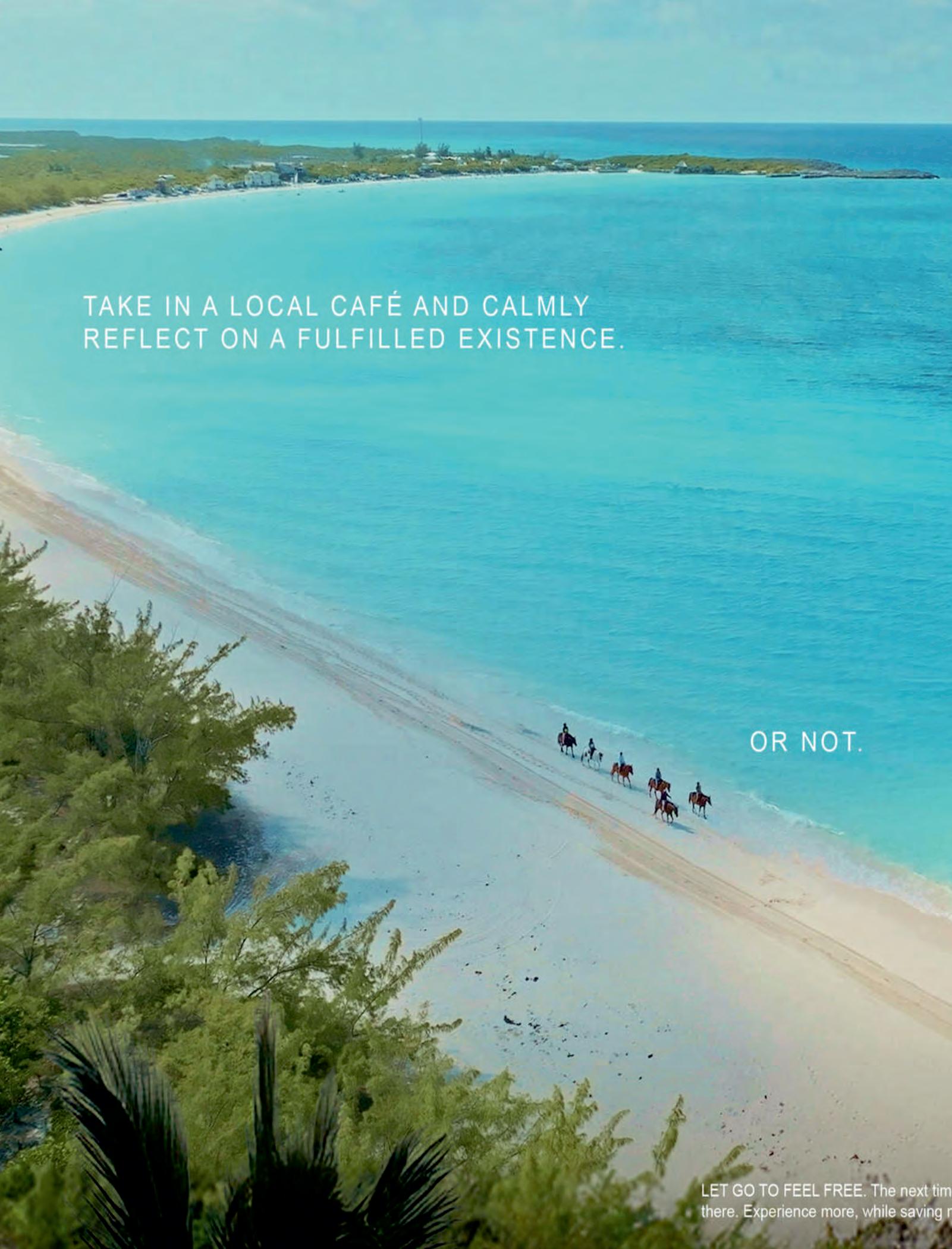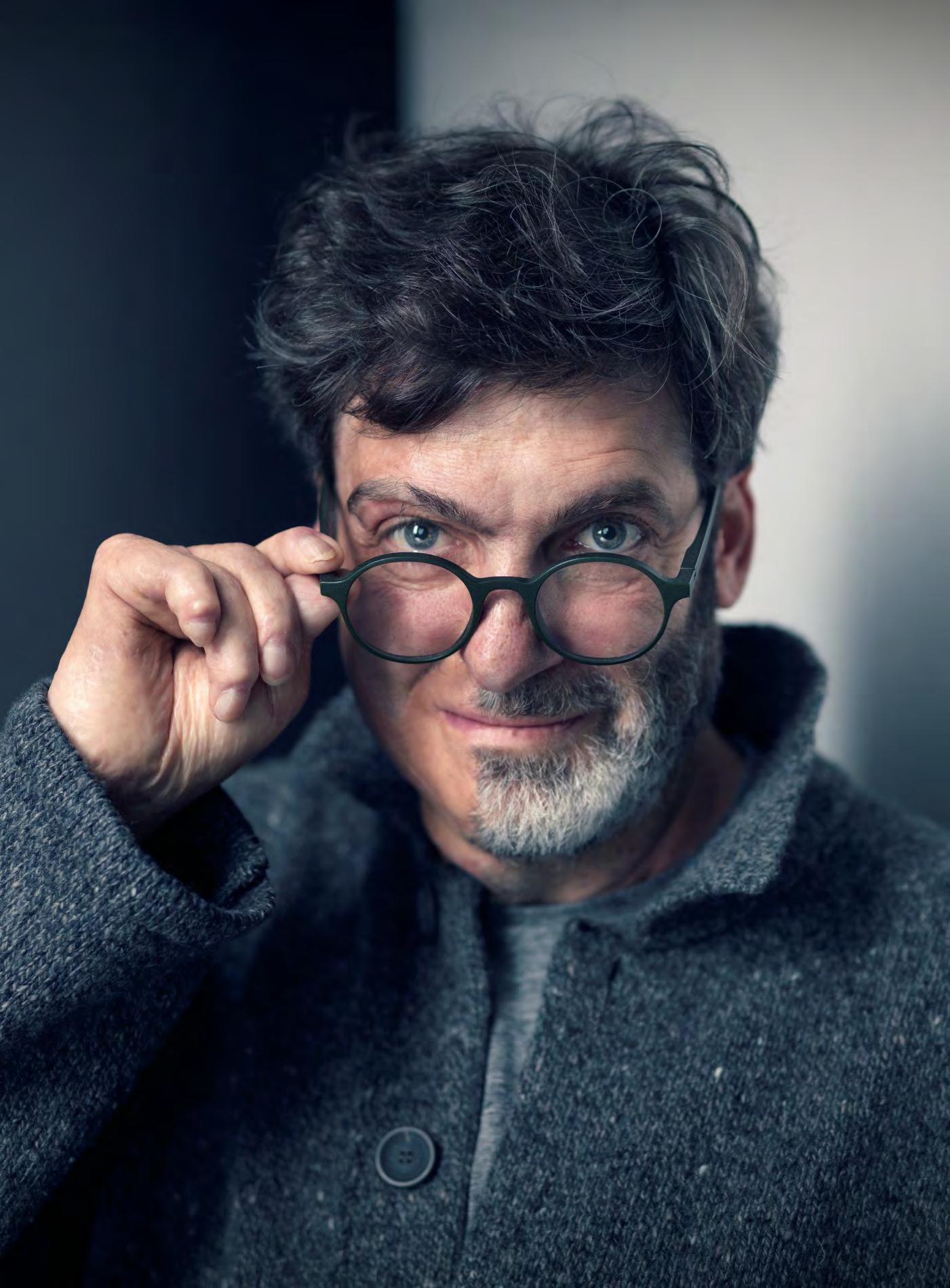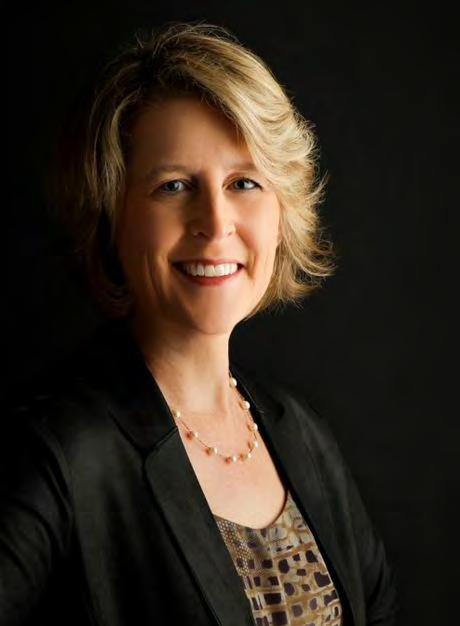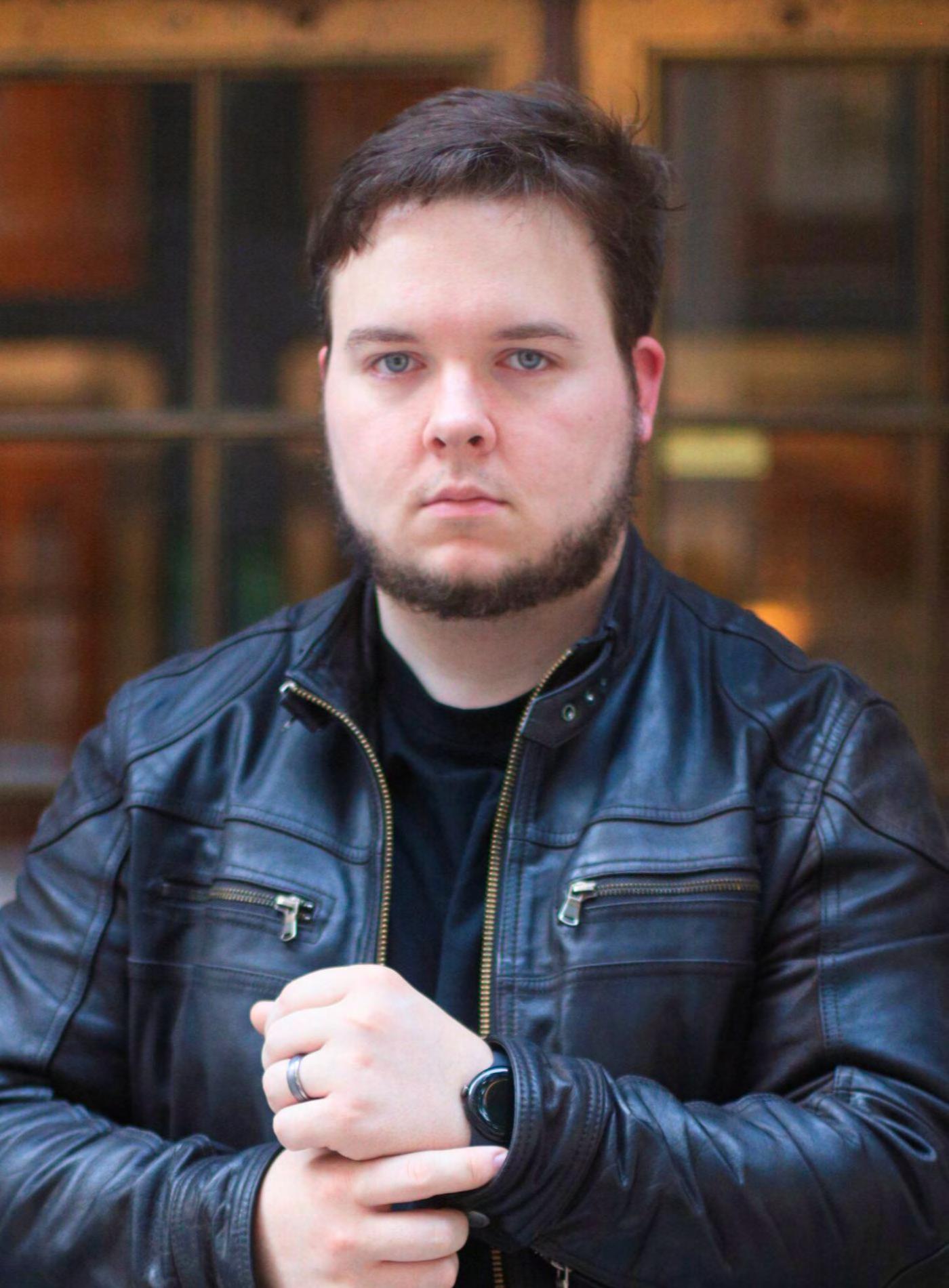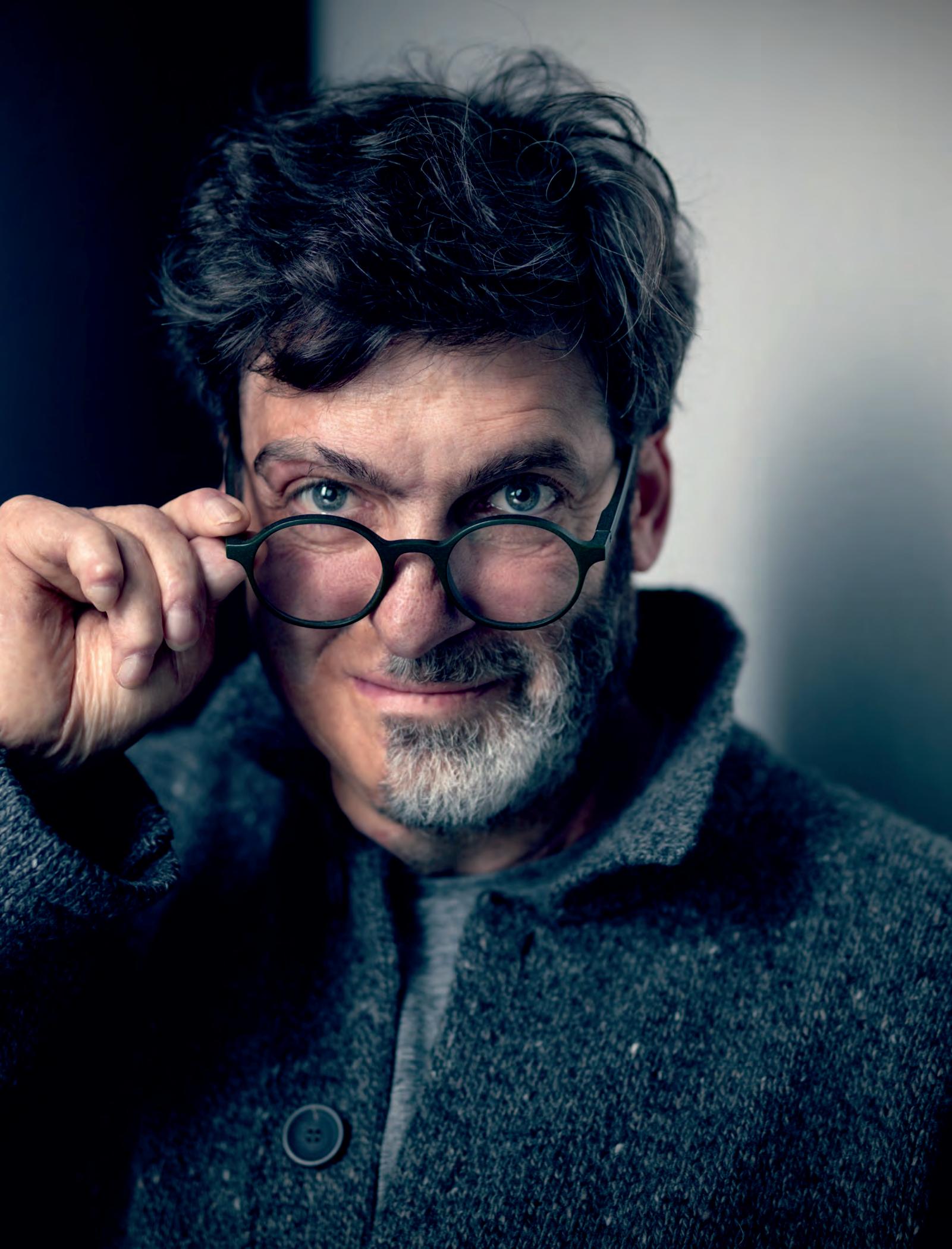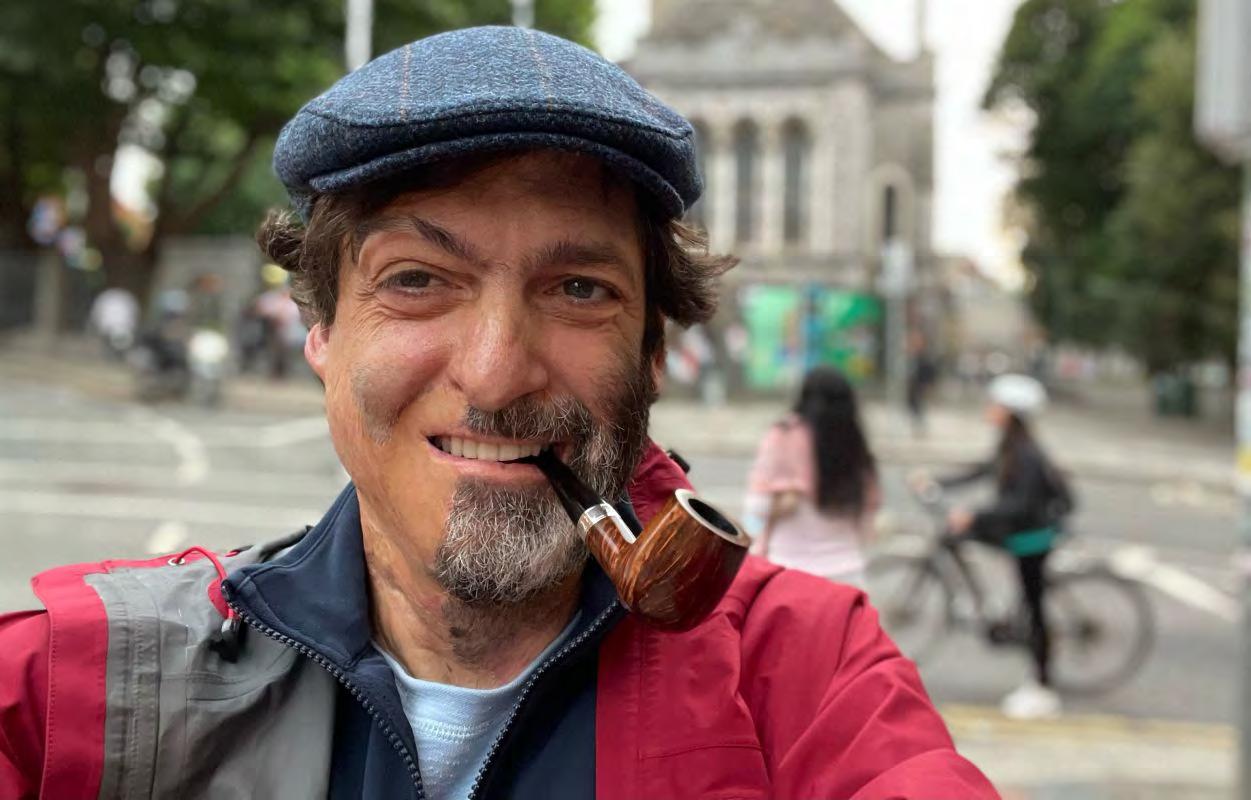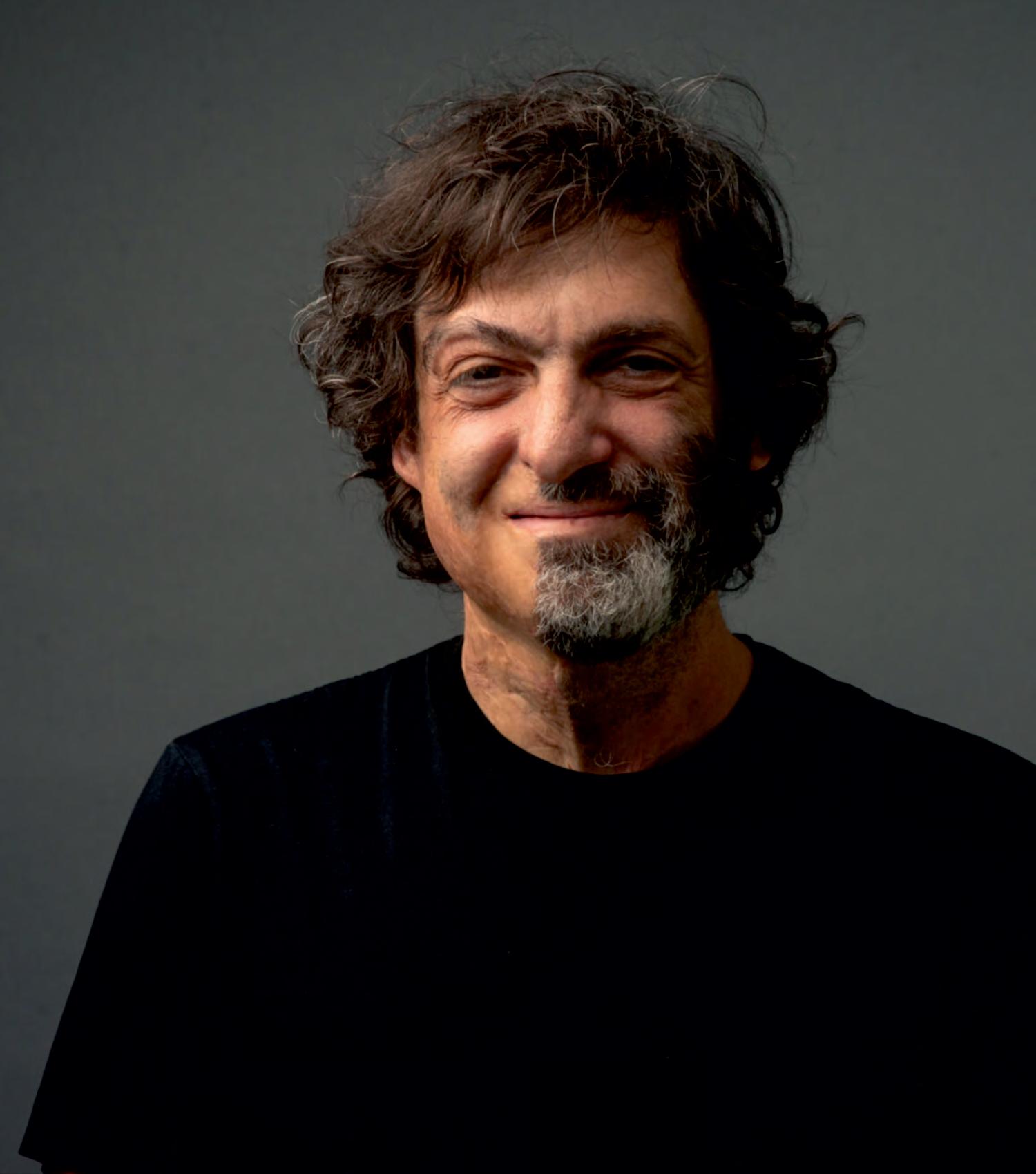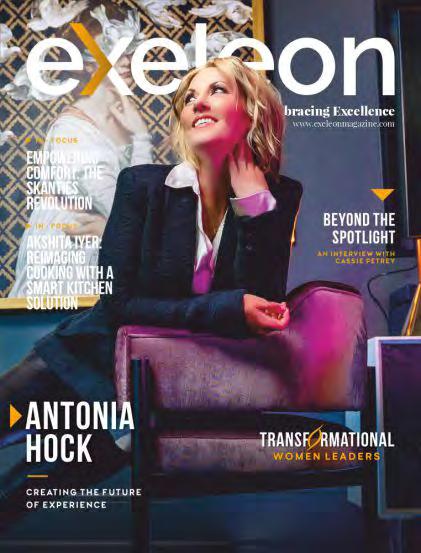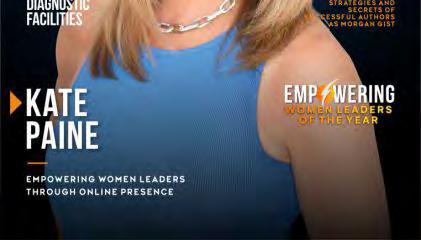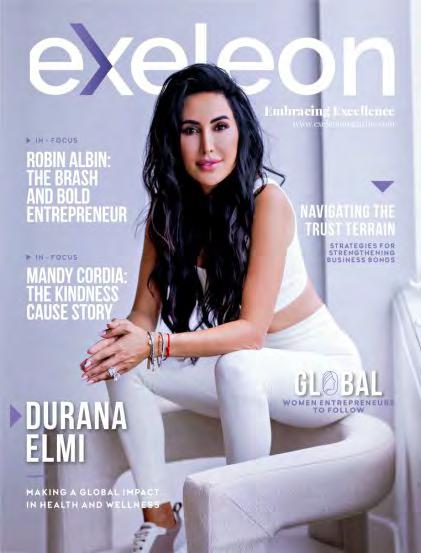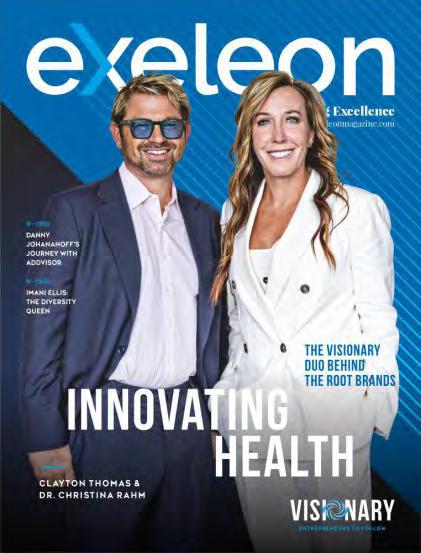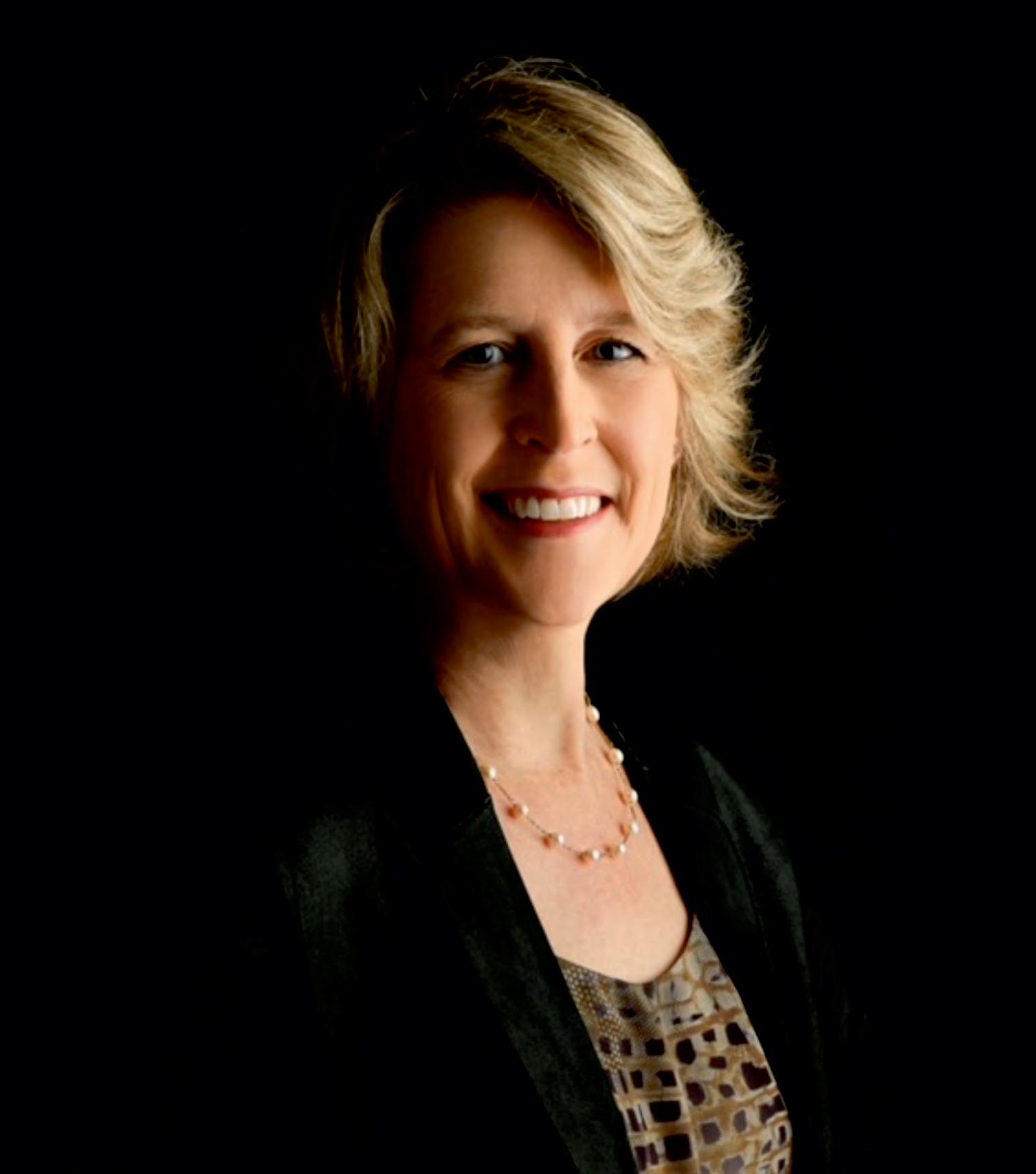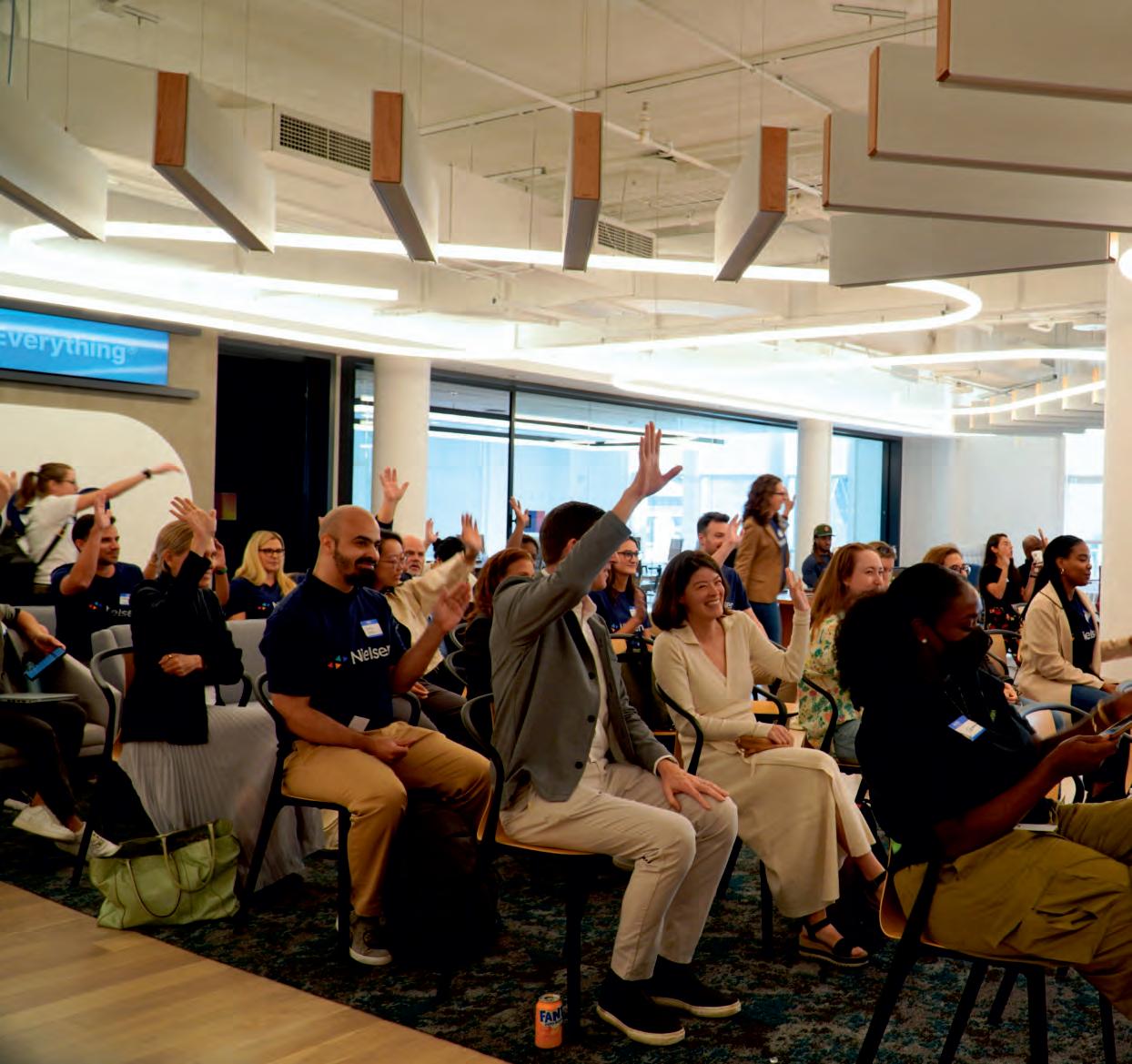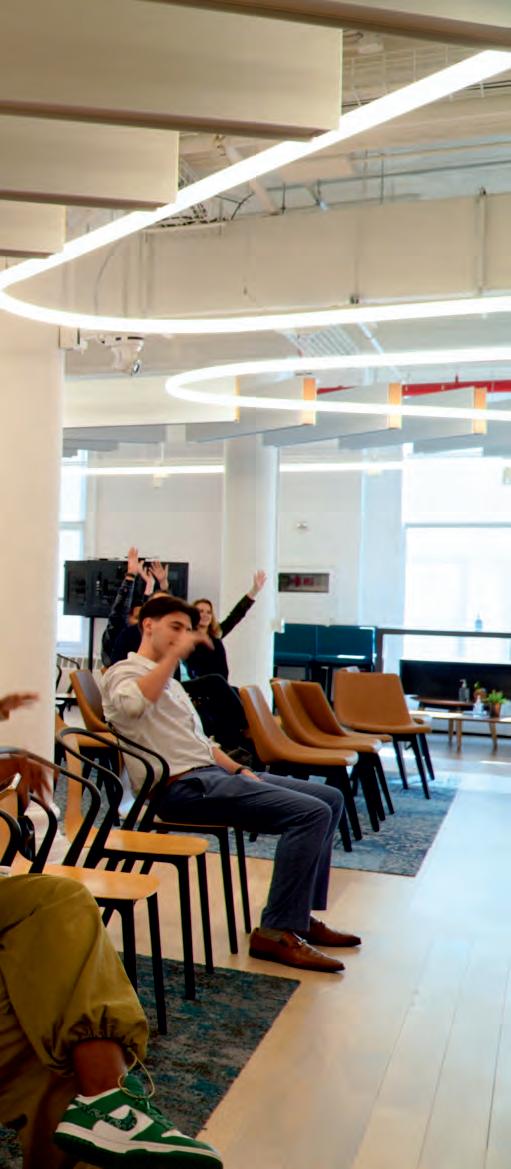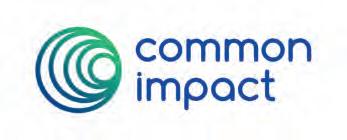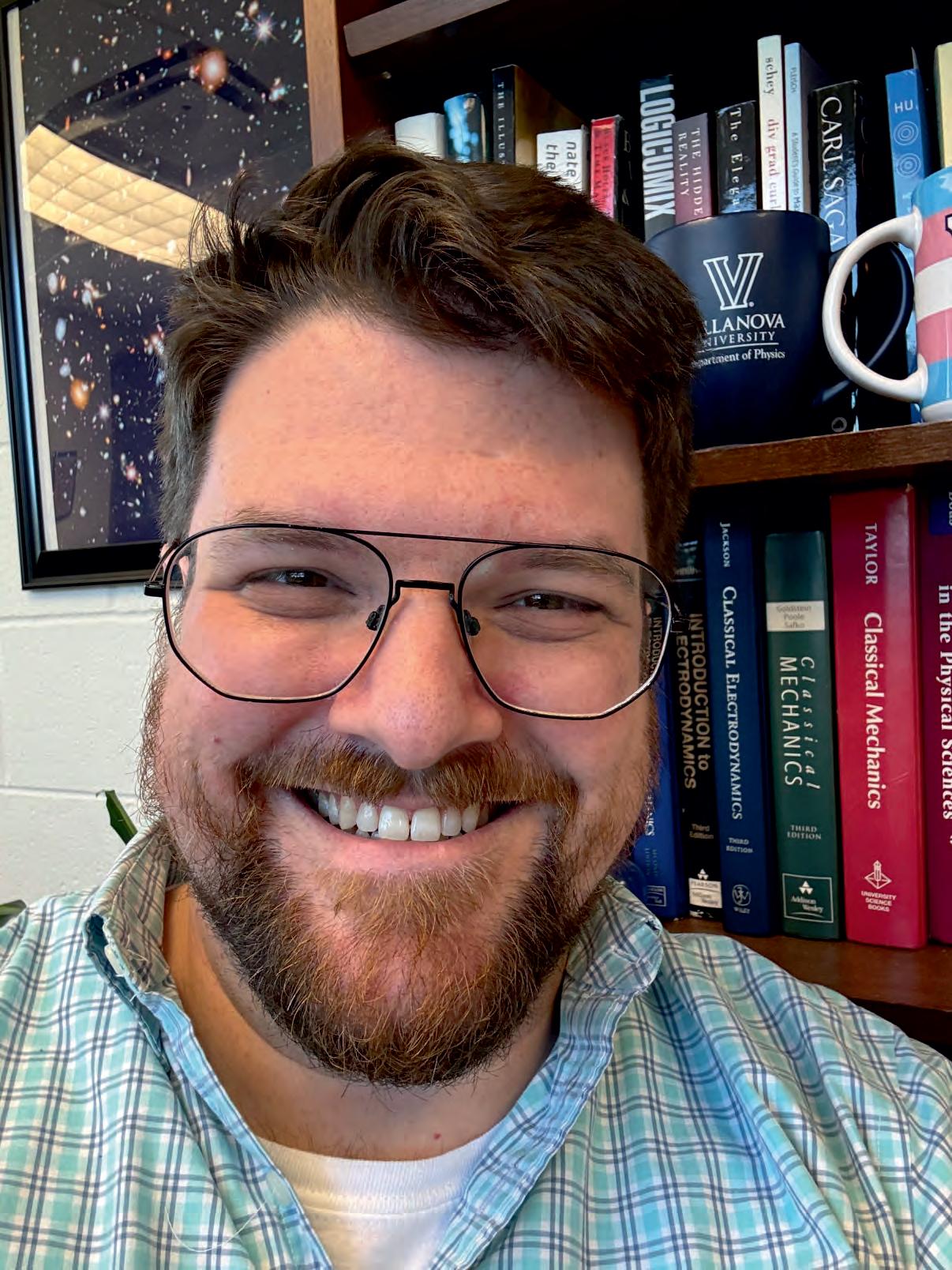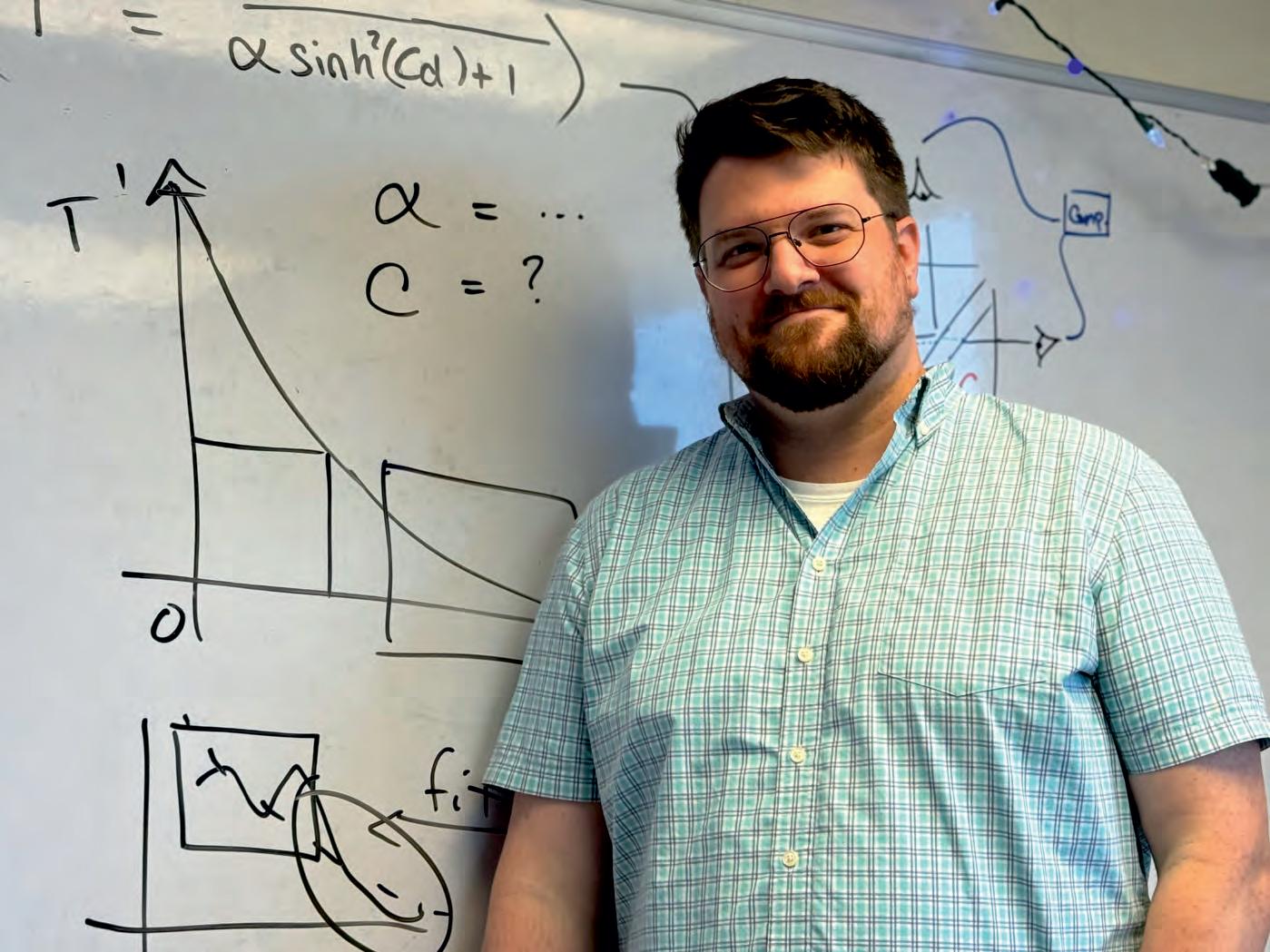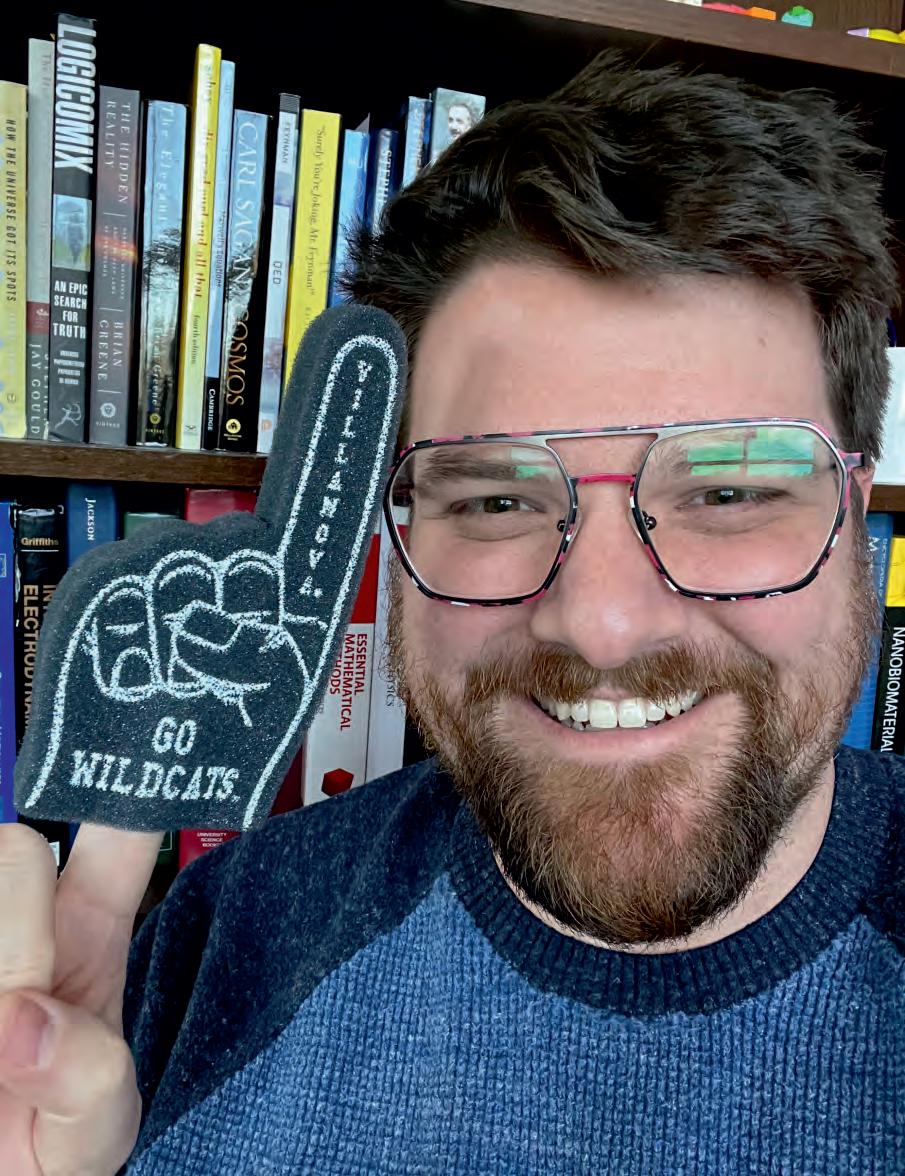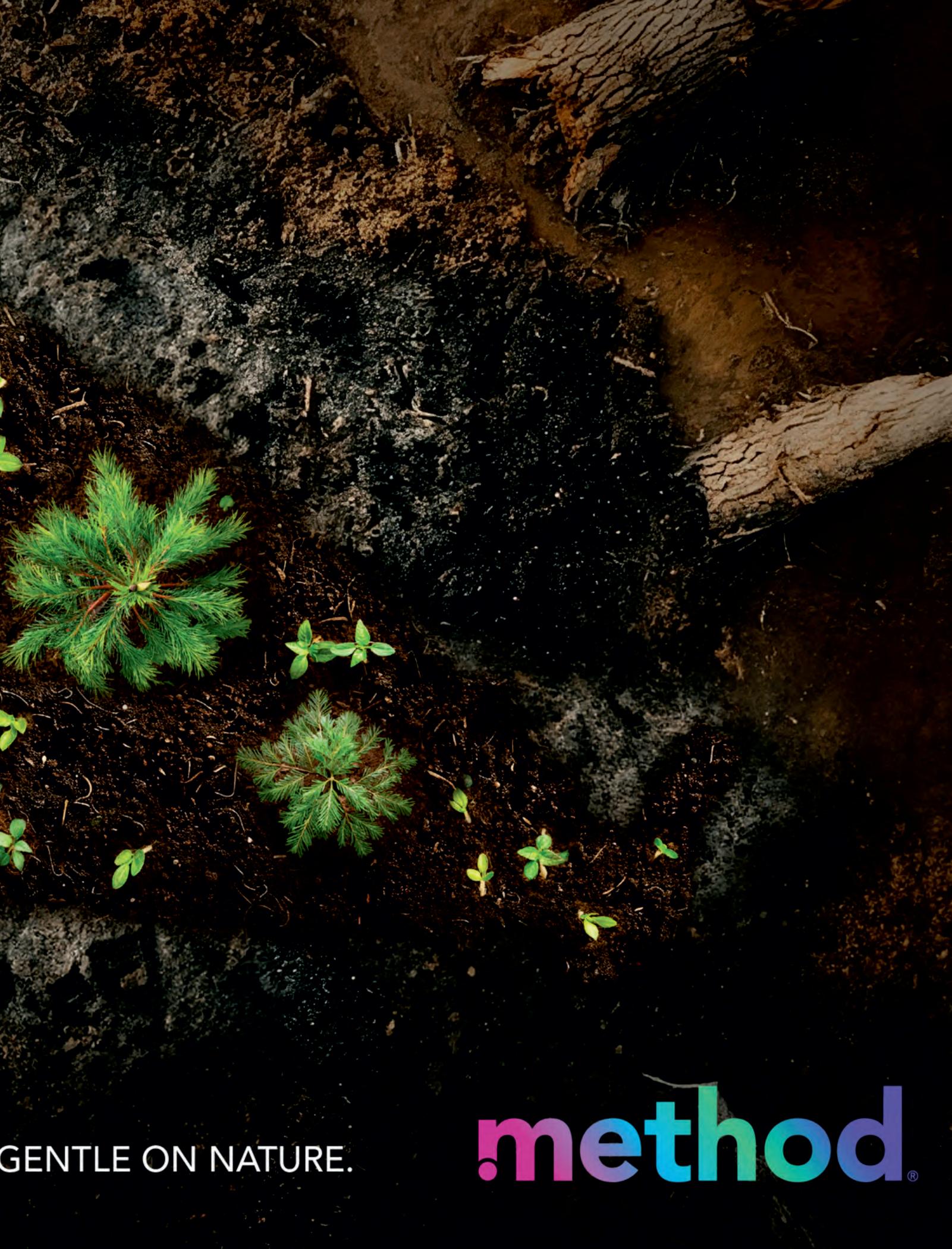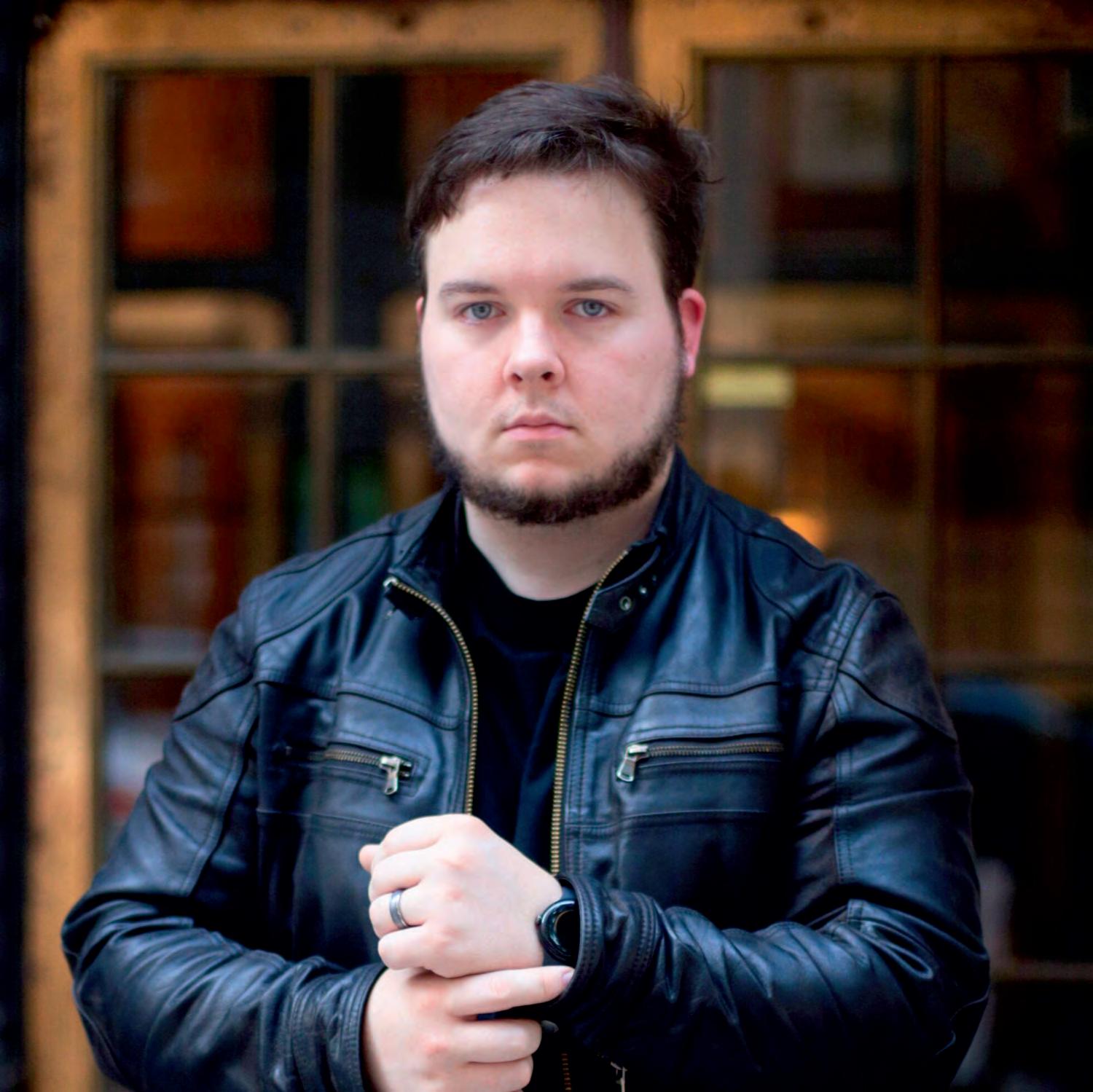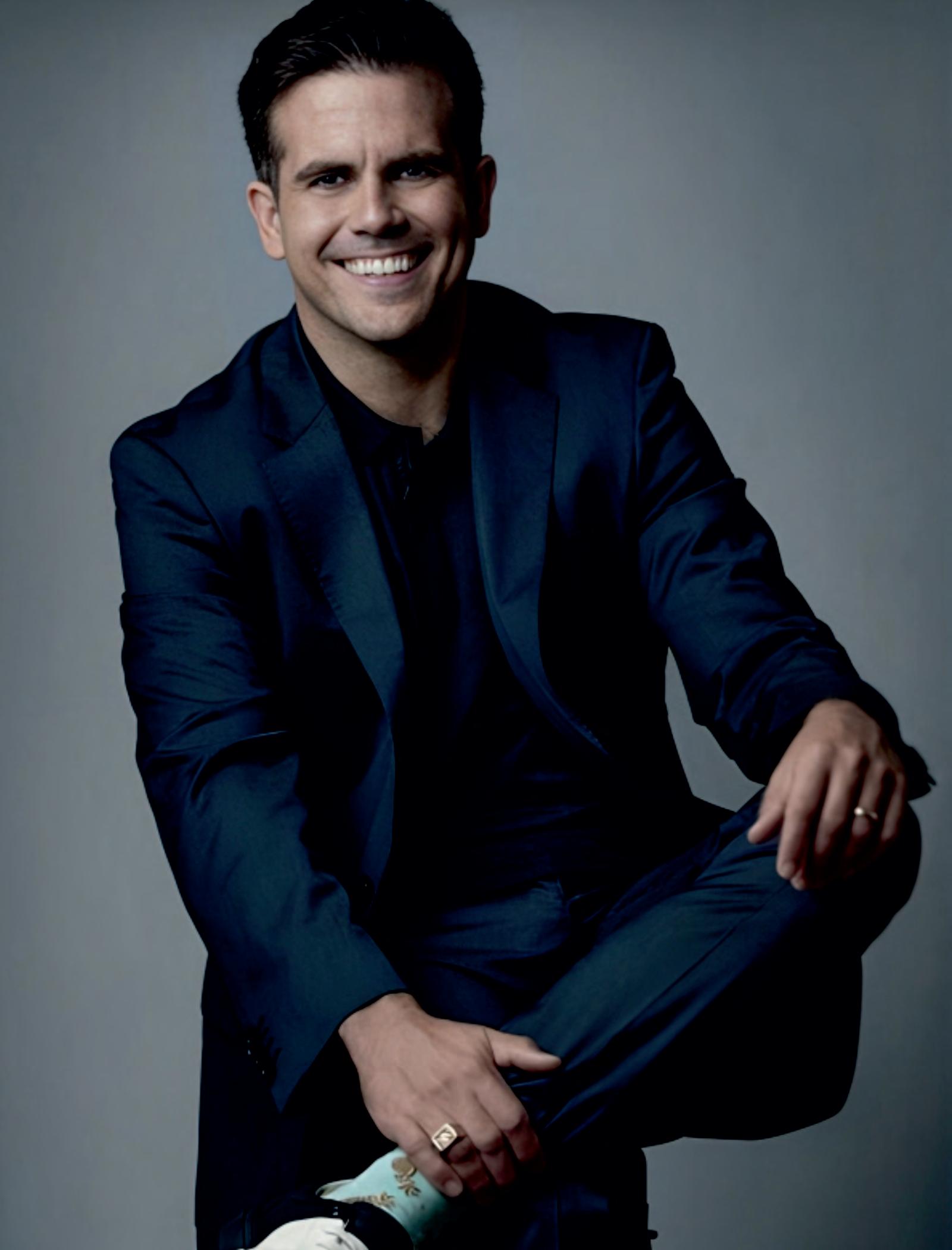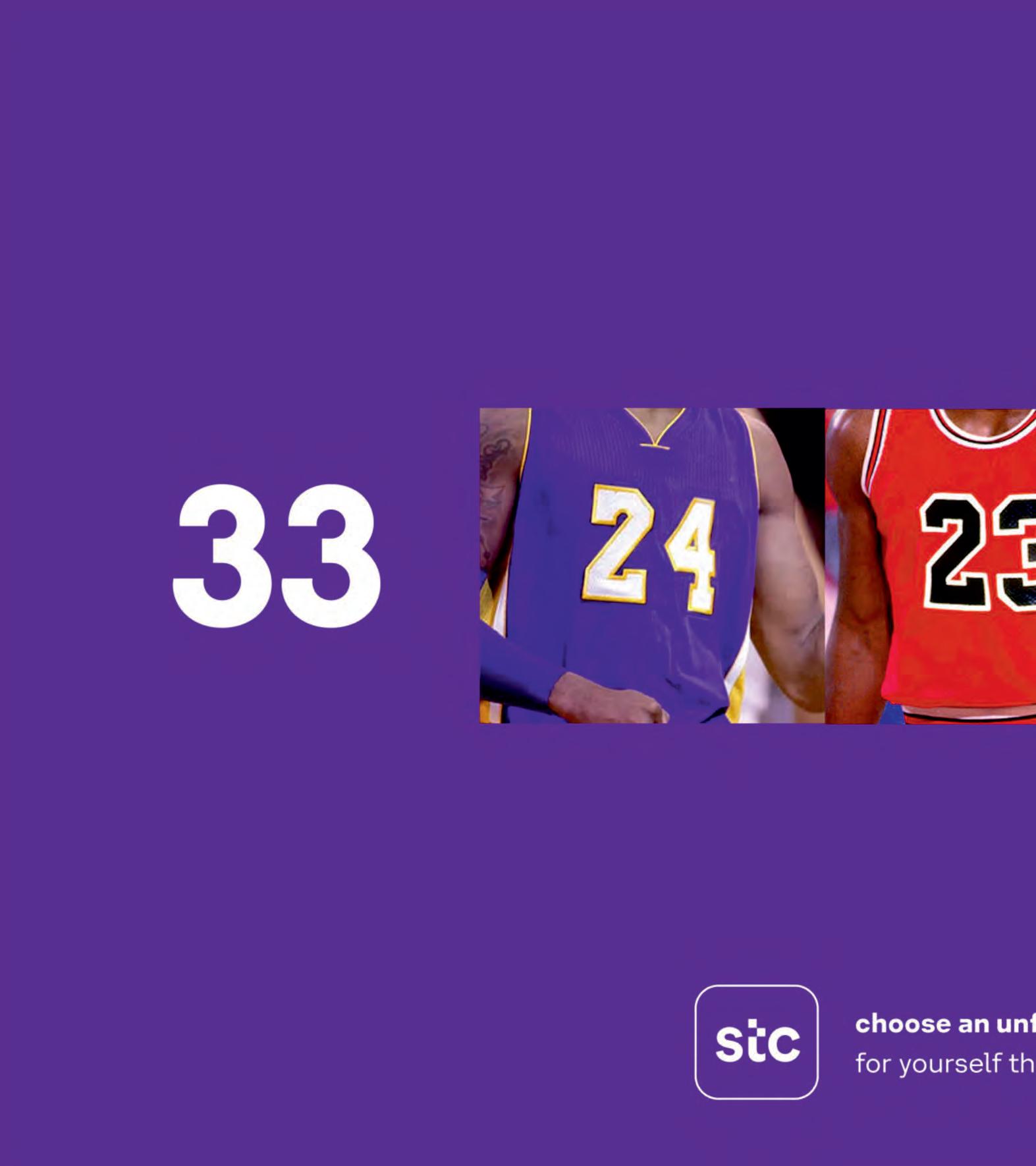Building Talent, Leaders, and Loyalty Through Social Impact: Why Skills-Based Volunteering Works IN -
Embracing Excellence
600 N Broad St 5 Middletown, DE 19709, United States +1 302-907-9110
Editor-in-Chief –
Art Director –
Naomi Lam
Managing EditorCreative Director –Daryl Yeung
Matt Reis Adam Waring
Project Manager –
Marketing Manager –
Customer Relationship –
Business Development –
Richard Dann Sofia Brown
Natasha Green
Matt Hale, Josh Wilder, Anish Miller
For any advertising related information, please contact info@exeleonmagazine.com. Submissions as well as contributions to the magazine are welcome.
Take a moment and let us know about our magazine; whether it be about the design or a possible mistake, we would appreciate any feedback from your end. You can reach out to daryl@exeleonmagazine.com.
DAN ARIELY 12
RACHEL HUTCHISSON DANARIELY Redefining Rationality and the Human Condition An Unconventional Path to Science ForDanAriely,thejourneyinto behavioraleconomicsdidnotbegin inaclassroomoraresearchlab,it beganinahospitalburnunitwhen hewasjust18.Anexplosionlefthim withburnsover70percentofhis body,andthetreatmentthat followedlastednearlythreeyears.It wasanexperiencethatintroduced himnotonlytoprofoundphysical painbutalsotothecomplexnature ofhumanbehavior.
Duringhishospitalstay,Ariely observedhowmedicalstaff approachedthedailyanddeeply painfulritualofbandageremoval. Theprevailingwisdomwastorip bandagesoffquicklytominimizethe durationofpain.ButAriely,who livedthroughtheseprocedures, wonderedwhetherthatapproach
trulyservedthepatient'sbest interests.
Later,asauniversitystudent,he revisitedthisquestionthrough experimentationanddiscoveredthat slowbandageremoval,though longer,waslesstraumaticoverall. Thatrealizationsethimonapath.
Hisearlyexposuretopain,control, anddecision-makingseededa lifelongcuriosity.“Lifeinhospitalgot mepassionateaboutmakingthe livesofpatientsbetter,”herelects.
Moreover,itledhimtoaska fundamentalquestionthatcontinues toguidehiswork: How can we improve decisions in the face of dif�iculty, uncertainty, and irrationality?
From Philosophy to Behavioral Economics Ariely'sacademicpathdidnotfollowastraightline. Heinitiallystudiedphysicsandphilosophy,drivenby aninterestinhowpeopleunderstandtheworld.Over time,hetransitionedintopsychologyandultimately behavioraleconomics,a�ieldthatexaminestheoftenirrationalwayspeoplemakedecisions.
Hisdiverseacademicbackground,ratherthanbeinga detour,becameanasset.“Mysenseisthatthething thatworksbestformeistheprocessbywhichI approachproblems,”hesays.Thatprocessbegins withacentralassumption:peopleareamateursat manyofthetaskstheyfaceinlife.
Whetherexploringonlinedating,savingsbehavior,or end-of-lifecare,Arielyasks:Whatifpeoplearenot skilledatthis?Howmightwehelpthemmakebetter choices?“Mygo-toapproachforalmostanyproblem istoaskmyselfandthepeopleI'mworkingwith, whatifpeoplewereamateursatX?”heexplains.This mindsetallowshimtodesigninterventionsthat acknowledgehumanlimitationswhileimproving outcomes.
Arielycreditshisintellectualversatilityinparttohis broadeducationalfoundation,andheoften recommendsthebook Range byDavidEpstein,which arguesforthepowerofgeneralistsinaspecialized world.Hisworkstandsasatestamenttothat philosophy.
Mentors, Pain, and Inquiry Throughouthiscareer,certainindividualshave shapedAriely'sthinking.Chiefamongthemwas ProfessorHananFrank,whobecamebothamentor andamodel.LikeAriely,Frankhadenduredlifealteringinjuries,losingbothlegsinamilitaryattack beforebecomingaprofessor.
Frank'sin�luencewastwofold.First,hetaughtAriely toapproacheveryquestionthroughexperimentation. “Hedidnotgiveustheanswerorsendustoreadto �indtheanswer.Instead,hisgo-toapproachwasto �irstaskus:Howwouldweconductanexperimentto explorethisquestion?”ThispracticetaughtAriely thatresearchisnotabstract,it'satooltounderstand andimprovelife.
Balancing Roles, Pursuing Impact Asaresearcher,professor,author, andentrepreneur,Arielywears manyhats.Hisworkspansacademic research,publicengagement,and practicalapplicationsinpolicyand business.
Whenaskedhowhemanagesthese diverseroles,heoffersasimple measure: progress.
“IjudgemyselfintheprogressthatI make,andIfeelthatallthesepaths areusefulpathsformaking progress,”hesays.Atanygiventime, thesourceofthatprogressand satisfactionvaries.Currently,itlies intwoareas:writinganewbookon riskandcontinuinghisresearch intoend-of-lifecare.
Thebookexamineswhypeople oftenshyawayfromriskand exploreshowtheymightembrace moreuncertaintytoleadfullerlives. Itisatopicthatconnectstomanyof Ariely'scoreinterests:decisionmaking,fear,andthepursuitof meaning.
Second,Frank'swillingnesstoturnhispersonal painintoasubjectofinquiryinspiredArielyto dothesame.“Itmademerealizethatresearch doesnothavetobeaboutthingsthatarefarand distant,”henotes.“Thepersonalexperiencecan actuallyenhancethequalityoftheresearch.”
ThisbeliefcontinuestoinformAriely'swork, especiallyinhiscurrentresearchonimproving the�inalchapterofpeople'slives,fromthe momentofterminalillnessdiagnosisuntilthe end.Heisexploringhowindividualsand medicalsystemscanreducemistakesand improvequalityoflifeduringthiscriticaltime. Hisgoalisclear:tomaketheendoflifethebest chapteritcanbe.
Bridging Academia and Everyday Life OneofAriely'sdeiningqualitiesishis commitmenttomakingcomplexresearch accessible.Throughbooks,publictalks,andhis “AskAriely”column,hetranslatesacademic �indingsintopracticalinsights.Hismotivation stemsfromhistimeattheMITMediaLab, wherehe�irstquestionedthedividebetween scholarlyworkandreal-worldapplication.
“Asacademics,wewritepapersthatareeasyfor ustoreadbuthardforpeoplewhoarenot academicstoreadandunderstand.”ForAriely, thisrepresentedafailureofmission.
Universitiesexisttobene�itsociety,yetmuch academicknowledgeremainsinaccessibleto thepublic.
Determinedtobridgethisgap,Arielybegan saying“yes”toanyone–governmentagencies, companies,startups–whowantedto understandhowsocialsciencecouldimprove theirwork.Hebelievesitistheresponsibilityof scholarstohelptranslateknowledgeinto action.“Ialwaysfeltitwaspartofthe responsibilityofacademicstohelptranslate whatweknowtowhatthesepeoplewere interestedin.”
Beyondprofessionalapplications,Arielysees behavioralscienceasatoolforpersonalgrowth. Studyingourselves,hebelieves,isessentialto
livingbetterlives,andhehasdevotedmuchof hiscareertosharingthatinsightwithabroad audience.
Looking Ahead: Risk, Change, and Openness Askedwhatadvicehewouldgivetohisyounger self,Arielypointstoapsychological phenomenonknownasthe“endofhistory illusion.”Peopleoftenbelievetheyhavereached their�inalform,thattheywillnotchangemuch inthefuture.Yet,whenaskedaboutthepast decade,mostadmittheyhavechanged signi�icantly.
Arielyhopesthenexttenyearswillbringjustas muchgrowthasthelast.“Mostly,I'mhopingto beopentonewintellectualadventuresand experiences,”hesays.Hisprioritiesinclude continuinghisresearchonend-of-lifecareand helpingpeoplelivemorerisk-tolerant, meaningfullives.
Inbetweenallhiswork,Arielyremainsguided bytheconvictionthatunderstandinghuman behaviorcanimprovethehumancondition.His researchbeganwithpersonalpain,butithas grownintoabodyofworkthatchallenges assumptions,reshapespolicies,andofferstools forbetterdecision-makingineveryfacetoflife.
Conclusion: The Purpose of Progress DanAriely'sjourney,fromaburnunittothe forefrontofbehavioraleconomics,isa testamenttoresilience,curiosity,anda commitmenttoimprovinglives.Hehastaken deeppersonalexperiencesandusedthemasa lenstoexamineuniversalquestions.Howdowe dealwithpain?Howdowemakedecisions? Howcanwelivebetter,fullerlives?
Throughhisresearch,writing,andpublic engagement,Arielyhasmadethestudyof irrationalitynotonlyaccessiblebutrelevant. Hisworkchallengesustoseemistakesnotas �laws,butasopportunitiesforunderstanding andgrowth.
Unlock Your DIGITAL SUBSCRIPTION! Ready to fuel your ambition and receive your dose of inspiration directly to your digital doorstep?
Subscribe to Exeleon Magazine today, and enjoy the following perks:
Convenience at Your Fingertips
Access each issue on your preferred digital device anytime, anywhere.
Exclusive Extras Dive deeper with bonus content, behind-the-scenes interviews, and special features reserved for our esteemed subscribers.
Community Connection
Join a network of likeminded individuals, share your story or interview, and be part of a thriving entrepreneurial community. SIMPLY SCAN AND SUBSCRIBE
Building Talent, Leaders, and Loyalty Through Social Impact: Why Skills-Based Volunteering Works By Rachel Hutchisson, CEO of Common Impact
Areyoualeaderlooking forwaystostrengthen youremployees'skills beyondtraditionallearningand developmentprograms?Ifso,it maybetimetotakeacloser lookatskills-based volunteerism(SBV).
Today'semployeesareseeking opportunitiestogrow,sharpen theirskills,andseeaclearpath forwardintheircareers.People leadersareworkingtoanswer thesecallsbutindit challengingtodeterminehow todeliverthatdevelopmentin waysthattrulyengageand inspire.Oftenviewedonlyasa waycompaniesgivebackto theircommunities,SBVisalso apowerfulwaytobuildyour talent'sskills,leadership,and con�idence,allwhiledelivering realimpacttothecommunity.
TheconceptbehindSBVis
simple:matchtheprofessional expertiseofemployeeswith nonpro�itprojectsthatstretch theirabilitiesandexpandtheir perspectives.Forexample,an HRteamre�ininganonproit's employeehandbooksharpens theirpolicyrecalland communicationskills.ITand procurementstaffadvisingona newCRMselectionstrengthen theirvendormanagementand decision-makingcapabilities. Marketingspecialistsauditinga nonpro�it'swebsitenotonly boostengagementforthe nonpro�it,butalsohonetheir analyticalskillsandcreative problem-solving.Thisapproach differsfromtraditional volunteerismbecauseofthe outsizedimpacttheresults creates.Itempowers nonpro�itswithlong-term solutionsandgivesyour employeesopportunitiesto applytheirexpertiseinnew
ways,thinkcreatively,and strengthenleadershipskills.
SBV gives employees opportunities to:
Value their current skill sets. It'snotuncommonforyour peopletolosesightoftheskills theyalreadyhave,takingfor grantedwhattheydoevery day.Puttingtheminsituations wheretheyapplythoseskillsto helpnonpro�itsgivesthem perspectiveandarenewed appreciationforthedepthand valueoftheirexpertise.
Develop new skills.
WorkingonSBVprojectswith nonpro�itsprovidesyour peoplewiththechancetotry outnewskills.DatafromARES tellsusthatpeoplewhotake partintheseinitiativeswalk away feelingmorelikelyto haveopportunitiestogrow
professionally(70%)anddevelop newskillsatwork(72%).These projectscreateanenvironment whereemployeescanexperiment withnewapproaches,explore toolsandtechniques,andpickup practicaltipstheycanbringback totheof�ice. Whendonewell,SBV projectscreatecollaborativespace forskill-buildingthatstayswith employeeslongaftertheproject ends.
Develop leadership muscle.
Forthosenotyetinmanagement roles,SBVoffersunique opportunitiestoleadgroupsof people,buildadaptability,manage nuance,andcommunicate effectively.Themoreoften employeesareencouragedto participateintheseactivities,the morecon�identtheybecomeas leaders,anotoriouslyhard competencytoteach,butonethat
developsnaturallyinSBVprojects wherepeoplemustinnovateand problem-solvequickly.
Build their networks, internally and externally.
Finally,SBVhelpsyourpeople makeconnections,bothinthe companieswheretheyworkand withothersinthecommunity. Workingalongsideprofessionals fromotherdivisionsprovidesa
glimpseintootherpartsofthe businesswhilecreatingvaluable personalconnections,whichpay dividendswhentheycomeback intotheofice.SBԀVengagements canbedesignedwiththe company'sgoalsinmind.Some projectsaretailoredforearlycareeremployees,givingthemthe chancetodivein,collaboratewith peersfromotherdepartments,and gainexposuretodifferentareasof
thebusiness.Othersbringtogether senioremployeesandearly-career staff,creatingopportunitiesfor mentorshipandknowledgesharing.SBVcanalsobestructured foremployeesatleadership threshold,providingan environmenttostrengthen strategicthinking,conidence,and skillssotheyreturntotheirroles readytodemonstratetheir leadershipcapabilities.
ThebeneitsofSBԀVdon'tstopwith skilldevelopment.Accordingtoa surveyof1,200employeeswho participatedinCommonImpact SBVprojects,96%reportedfeeling morepositiveabouttheir employersandmorelikelyto recommendtheircompaniesas greatplacestowork.Thisspeaks toSBV'spowerasanengagement andretentiontool.When employeesseetheircompanies investinginmeaningfulworkthat alignswiththeirvalues,their connectiontotheorganization grows.Thatsenseofconnectionis highlymotivating,inspiring employeestoseetheirworkplace notjustasajob,butasaplaceto growandcontribute.Otherdata fromARESpointstolower employeeattritionamongthose whoserve,suggestingthatthe senseofpurpose,skillgrowth,and cross-teamconnectionsdeveloped throughSBVcontributedirectlyto strongeremployeeloyaltyand satisfaction.
Whetheryouhaveaspeci�icgroup inmindorsimplywanttohelpall yourteamsthrive,SBVoffersa strategicwaytoinvestinthe peoplewhopoweryourcompany's success.Well-designedSBV programsstrengthenleadership
pipelines,boostretention,foster cross-teamcollaboration,and deepenemployeeloyaltyby connectingpeoplebothwithinthe companyandtomeaningful causes.Whenemployeesfeelmore connectedandpurposeful,they experienceaboostinoverallwellbeingandthepositiveimpactthey createinthecommunityrelects backonyourbrand,culture,and long-termsuccess.
About the Author:Rachel HutchissonisCEOofCommon Impact,anonproitaligning purpose-drivencompanieswith nonpro�itstopropelsocialgood. Withmorethan20yearsof experienceincorporatesocial responsibility,Rachelhaslong beenachampionfortherole businessesplayinservingothers.
About Common Impact:Common Impactisanationalnonproitthat fostersmeaningfulpartnerships betweenpurpose-drivenFortune 500companiesandnonproits worldwidetopropelsocialgood. Since2000,CommonImpacthas generatedover205,000hoursof skills-basedvolunteeringand$62 millioninresources.Common Impactisdedicatedtohelping nonpro�itsexpandtheircapacity, improveef�iciency,anddeliveron theirmissionwithcustomizedand impactfulprojectsthrough corporatepartnerships.Learn moreaboutCommonImpact's services impact,andclients. ,
Dr. Randal A. Collins
The Future of Crisis Leadership: Why Every Organization Needs an Incident Management Team Theworldisshifting beneathourfeet.Faster thanever.More unpredictably.More dangerously.Disasters—both naturalandman-made—are becomingmorecomplex,more devastating,andmorefrequent. Yet,toomanyorganizations clingtooutdatedcrisis managementmodels,hoping theywillworkjustonemore time.Theywon't.
Thefutureofcrisisleadership willbelongtothosewhocan thinkfasterthanthecrisis,see furtherthanthedisaster,and adaptbeforetheyareforcedto. Itwillbelongtothosewho embraceAdaptiveEmergency Management—anapproachthat is�lexible,decentralized, innovative,andcollaborative.It willbelongtothosewhoinvest inIncidentManagementTeams (IMTs).
What is an Incident Management Team?
AnIncidentManagementTeam (IMT)isaspecializedgroupof
leaders,planners,logisticians, andcrisismanagerstrainedto takecommandwhenchaos threatenstooverwhelman organization,acity,orevenan entirenation.Theseteams operateinbusiness, government,andthenonproit sector—anywhere organizationsneedtomanage andrecoverfromcrises ef�iciently.
AnIMTdoesnotreplacethe needfororganization-wide preparedness.Everyemployee mustunderstandthebasicsof continuityplanning,disaster response,andriskmitigation. ButanIMTisdifferent.
Itisacrisisleadershipteam, carefullyselected,rigorously trained,andstrategically exercisedtotakechargewhen disasterstrikes.Itisthe differencebetweena�iredrill andanelite�ireresponseteam. Onepreparestheentire organizationforsafety.The otherensurestheorganization survivesthe�ire.
Why Your Organization Needs an IMT
Disastersdonotdiscriminate. Whetherintheprivatesector, government,oranonproit organization,criseswillcome. Andwhentheydo,theresponse willdeterminewhetherthe organizationweathersthe stormorcollapsesunderits weight.AnIMTensuresthat resourcesaremaximized, decisionsareclear,and operationsremaineffectivein thefaceofdisruption.Whether respondingtoacyberattack,a supplychainfailure,anatural disaster,oraworkplacecrisis, anIMT:
•Organizesdisasterresponse soaidisdeliveredfaster andmoreeffectively
•Managesmulti-agency coordinationtoprevent bureaucraticslowdowns
•Ensuresdecision-makers havethereal-time intelligencetheyneed
•Preparesanorganizationto survive,recover,and rebuildmoreef�iciently
Adaptive Emergency Management: The New Standard for Crisis Leadership
Emergencymanagementcannotbe static.Itmustevolvewiththe threatsitfaces.Theold, bureaucratic,slow-movingmodels arenolongerenough.Rigidsystems break.Adaptivesystemssurvive.
FiveprinciplesdeineAЀdaptive EmergencyManagement:
1.Flexibility–Theabilitytopivot, changecourse,andimprovisein real-time.
2.Decentralization–Empowering thoseclosesttothecrisistomake decisionswithoutwaitingfor approval.
3.ContinuousLearning–Every disasterisalesson.Everyfailure,an education.
4.InnovationIntegration–Leveragingnewtechnologies,AIdrivendata,andreal-timeanalytics. 5.Collaboration–Breakingdown silosbetweenagencies, departments,andstakeholders.
Thebestcrisisplansarenotthose followedstepbystep—theyarethe onesthatcanberewrittenonthe �lyandexecutedbyanIMTthathas trainedandexercisedtogetherto thrivewithinthechaos.
The Cost of Leadership Failures
Executives,electedoficials,and CEOswillhavetomakeachoice. Theywillneedtoselecttheircrisis managementpersonnelbasedon meritandquali�ications—andwhen theydon't,theconsequenceswillbe painful.
•Whenleadersfailtofund prevention,preparedness,and mitigationefforts,theywill beartheresponsibilitywhen
disasterstrikes.
•Whenleadersneglecttoinvest intheirIncidentManagement Teams,theywillrealize—too late—thatitwasagovernance mistake.
•Whenprofessionalcrisis managementstandardsare treatedasoptional,theprice willbepaidinlostlives,ruined businesses,andfailed responses.
Thecostofnotimplementing AdaptiveEmergencyManagement willbefargreaterthanthecostof doingitrighttheirsttime.The failuresofgovernancearealready writtenintheashesoftheLahaina Fire,theLosAngelesWild�ires, HurricanesHeleneandMilton,the BoeingLaborStrikeCrisis,the CrowdStrikesoftwarefailure,and otherpoorlymanagedcrises.These arenotnewlessons.Theyhave beentaughtoverandoveragain.
Investing in the Future of Crisis Leadership Crisismanagersmustbebetter trained,betterprepared,andbetter supported.Thenextgenerationof crisisleaderswillneedto understandreputation management,AI-drivencrisis communications,real-time situationalawareness,andmultiagencycoordination.Theywillneed toknowhowtointegrateInternet ofThings(IoT)data,track emergencylogisticsthrough blockchainsystems,andengage independentmediacreators alongsidetraditionalnewsoutlets. Thecrisismanagerofthefuture cannotrelyonyesterday'smethods.
The Role of IMTA TheIncidentManagementTeams
Association(IMTA)isdedicatedto advancingandsupportingtheuse ofIMTsacrossallsectors.IMTA providestraining,resources,anda networkofprofessionals committedtoimprovingcrisis leadershipateverylevel.For organizationsseekingtostrengthen theircrisismanagementprograms, beinginvolvedwithIMTAoffers accesstobestpractices,expert guidance,andacommunityof professionalswhounderstandwhat ittakestoleadintimesofcrisis. FindoutmoreaboutIMTAat www.AHIMTA.org.
Thefutureofcrisisleadershipis beingshapednow.Organizations thatfailtoadaptwillpaytheprice. ThosethatinvestinAdaptive EmergencyManagementandIMTs willbepreparedforwhatever comesnext.
About the Author:
SincetheinceptionoftheIncident ManagementTeamsAssociation (IMTA)in2010,Dr.RandalA. Collins,CEMhasbeenaguiding forceinshapingitsmissionand impact.Asafoundingmemberof theBoardofDirectors,heservedas Vice-Presidentbeforeassumingthe roleofPresidentandCEOin2012,a positiontowhichhehasbeen repeatedlyre-electedduetohis reputation,experience,education, andleadershipintheield.Under hisleadership,IMTAhasbecome thenation'spremierorganization representingtheprofessionalswho specializeinbringingordertothe worstdisasterincidentsacrossthe country.
CHRISTOPHER D. BROWN Associate Teaching Professor of Physics, Villanova University
Inspiring Curiosity Through Physics ForChristopherD.Brown, physicshasneverbeen justaboutequationsor experiments—ithasalways beenaboutcuriosity.Fromthe momenthestumbledupona bookbyJimAl-Khaliliathis locallibrary,hewascaptivated bythemysteriesoftheuniverse andinspiredtopursueapath thatwouldeventuallymerge research,discovery,and education.
Today,asanAssociateTeaching ProfessoratVillanova University,Dr.Brownbrings thatsamesenseofwonderinto hisclassrooms.Hiscareer re�lectsajourneyshapedby pivotalmentors,unexpected opportunities,andadeep commitmenttoteachingasboth ascienceandanart.Inthis interview,heshareshowhis earlyinterestsevolved,the challengeshefacedalongthe way,andtheteaching philosophythatguideshimas hehelpsstudentsembracethe
beautyofphysics.
What key moments in your early life sparked your interest in physics and set you on the path to becoming an educator?
Irememberborrowingabook byJimAl-Khalilifrommypublic librarythatsparkedmy fascinationwiththevastnessof space,themysteriesofthe quantumworld,andthe paradoxicalnatureofrelativity. MyinterestgrewasItooktwo physicsclassesinhighschool withoneofmyfavorite teachers,Mr.BrentOhl.His enthusiasmpropelledmeto studyphysicsatFranklin& MarshallCollegeandlaterbegin teachingasaTeachingAssistant ingraduateschoolatDrexel University.
Can you describe a pivotal challenge you faced during your academic journey and
how you overcame it?
Earlyon,IthoughtIwantedto pursueexperimentalresearch incondensedmatter.Ihad researchexperiencewithDr. KenKrebsatFranklin& Marshallandlovedworkingin hislab.ButwhenIbegan graduateworkatDrexel,I quicklyrealizedthatmy undergraduateexperience didn'ttranslateintoasustained interestinthematerial.I worriedI'dfallbehindafter spendingayeariguringthat out.
WhenIreachedouttomy eventualthesisadvisor,Dr. FrankFerrone,aboutjoininghis experimentalbiophysicslab,he assuredmetherewasnoneed topanic—andhewasright.He introducedmetoacompletely newwaytotestforthepresence ofSickleCellDiseaseinblood samplesusingviscosity.Inever imaginedIwouldendupin biophysics,butthe
interdisciplinarynatureofthework wasfascinatingandprovedtobe theperfect�it
How did your transition from student to Associate Teaching Professor at Villanova University unfold?
Ididn'trealizehowmuchIwanted toteachuntilIbecameaTeaching Assistantingraduateschool.That experiencesolidi�iedmydesireto pursueteachingafter�inishingmy dissertation.BeingaTAalsohelped medeepenmyownunderstanding
ofphysics.ItaughtcloselyunderDr. Ferroneforthreeyearsandlater taughtcomputationalphysicslabs for�irst-yearmajorsfortwo years—aninvaluableexperienceI continuetodrawfrom.Nearthe endofmyprogram,avisiting teachingpositionopenedin Villanova'sphysicsdepartment. Withsomeencouragementand advocacyfromthedepartment chairatthetime,Dr.MichaelHones, thepositionevolvedintoa continuingrole,openingthedoorto thecareerIhavetoday.
What role did mentorship or key in�luences play in shaping your career trajectory in physics?
Mentorshipandcollaborationhave beenattheheartofmyjourney.My mentorsshapednotonlymy educationbutalsomycareer decisions,givingmeopportunities togrowandlourish.Icannot overstatehowmuchmycurrent positionistheresultoftheir guidance.
AtVillanova,I'vealsobene�ited fromfantasticpeermentorslikeDr.
DavidChussandDr.DanaSaxon. Equallymeaningfulhasbeenthe chancetomentorothers.I've supportednewteachingfacultyand launchedourdepartment's FirstYear Mentor Program,pairing incomingstudentswith upperclassmentohelpthem navigateacademicsandcampuslife. Beyondhelpingwithclass registrationor�indingtheshortest dininghalllines,thesepairings highlightthevalueofcollaboration overcompetition.Nowinitsthird year,theprogramhasbeenan overwhelmingsuccess.
Were there any unexpected turns or opportunities that signi�icantly altered your professional path?
Themostunexpectedopportunity cameattheendofmythesis.My advisorsawapostonsocialmedia fromaVillanovaprofessor—alsoa Drexelgraduate—whowastakinga shortleave.Heencouragedmeto reachouttothedepartmentchair toseeiftheyneededavisiting professor.Withintwoweeks,Ihad landedmyinitialpositionat Villanova.Thatopportunity ultimatelyledtomycurrentrole.
Iusedtothinknetworkingwasonly forbusinessstudents—howwrong Iwas!Myadvice:neverhesitateto reachouttoyournetwork.One conversationcanchangetheentire courseofyourcareer.
How has your teaching philosophy evolved over the years based on your personal and professional experiences?
AtDrexel,Itookpedagogycourses throughCASTLEdesignedforSTEM graduatestudentswithastrong
interestinteaching.Theyopened myeyestotheimportanceofactive learning.Earlyinmycareer,I leanedheavilyonthosetechniques, andtheyworkedwell.
ButtheCOVID-19pandemicshifted myperspective.IrealizedIneeded tothinkbeyondwhathappenedin classandcreatepoliciesthatwere equitable,�lexible,and supportive—withoutsacriicing rigor.Today,Icentermyteachingon
fosteringagrowthmindset.Itell mystudents:masteryispavedwith mistakes.Failureisn'ttheend;it's anopportunitytolearn,adapt,and grow.Thatbeliefnowshapesevery courseIteach.
Dr. Erica Forzani Engineering Human-Centered Health Innovation Dr.EricaForzanistandsatthe intersectionofchemistry, engineering,andhumanwellbeing,wherecutting-edgesciencemeets compassionatecare.Asapioneering researcher,educator,andentrepreneur, shehasdedicatedhercareerto translatingcomplexscienti�icideasinto real-worldmedicalsolutionsthatcan improve,andinsomecases,savelives.
Herpathisanythingbutconventional. Bornwithanaturalcuriosityand nurturedbyachildhoodilledwith scienceexperiments,mechanical tinkering,andlate-nighthospitalvisitsto seehercousininaclinicallab,Erica's journeyhasbeendeeplypersonal.It'sa storyrootedininspiration,drivenby
empathy,andpoweredbyanunrelenting desiretomakeadifference.Whatbegan withasimplechemistrykitgiftedbyher fatherhasevolvedintoalifelongmission todevelopbreakthroughbiosensing technologiesforsomeofhealthcare's mosturgentchallenges.
Today,withovertwodecadesof experience,morethan50scientiic publications,multiplepatents,andthe successfulcommercializationofher innovations,Dr.Forzaniisleadinganew generationofinterdisciplinarythinkers. Herworkbridgesacademiaand entrepreneurship,theoryandapplication, labresearchandpatientoutcomes.
Assheembarksonanewchapter withthePhoenixChildren's ResearchInstituteattheUniversity ofArizona'sCollegeofMedicine,Dr. Forzaniiscomingfullcircle, bringingherskillsbacktothe pediatrichealthcarespacewhere herpassion�irsttookroot.Inthis exclusiveinterview,sherelectson hercareer,thelessonsshe's learned,andwhythefutureof engineeringisn'tjustaboutdata anddevices,it'saboutpeople.
Your work bridges chemistry, engineering, and health sciences. What inspired your path into
such an interdisciplinary space?
My�irstinspirationwasmyfather. WhenIwas11,hegavememyirst chemistrykitandmicroscope.We spentcountlesshoursdoing experimentstogether.Healso invitedmetoworkwithhiminhis workshopandtohelpixhiscaron weekends.Ilovedhowheinvolved meinwhatweretraditionallyseen as"man'schores."Thatbondand thosesharedexperiencessparked myloveforscienceand engineering.
Later,mycousinLaura,whoworked
nightshiftsinaclinicalchemistry lab,inspiredmetopursuemedical laboratoryscience.Iremember howmuchIlovedvisiting“her”lab atthehospital.Iwasfascinatedby theclinicalenvironmentandthe rolediagnosticsplayedinpatient care.
Duringmyresidencyatachildren's hospitalinCórdoba,Argentina,I especiallylovedthenightshifts. Theyallowedmetocollaborate directlywithemergencydoctors andcontributetourgentdiagnostic cases.Whattrulymovedmewas seeingtheanxiousparentswaiting
forlabresults.Thatexperience mademerealizeIwantedtodo more—anddoitfaster.That'swhat ledmetopursueaPh.D.andshift myfocustoengineeringnew diagnostictools.
In2003,IjoinedArizonaState Universitytodevelopmy engineeringskillsandworkon sensortechnologies.Now,22years later,I'vecomefull circle—returningtopediatric healthcareatPhoenixChildren's HospitalthroughthePhoenix Children'sResearchInstituteatthe UniversityofArizona'sCollegeof Medicine(startingJuly2025).I'm beyondexcited.Itfeelsincredibly meaningfultodedicatethisnext chapterofmylifetoimproving children'shealththrough technology.
As a professor and researcher, how do you nurture creativity and innovation in your students while maintaining scientiic rigor?
It'sallaboutbalance.Iprovide timelyguidanceandconstructive feedbackwithoutmicromanaging.I alignstudentswithprojectsthat matchtheirpersonalgoals,give creditwhereit'sdue,and encouragecollaborationboth withinourteamandwithexternal partners.Whenstudentsfeel ownershipandconnection, innovationcomesnaturally—and futureleadersareborn.
What do you �ind most ful�illing about your role as an educator in the ield of engineering and biosensing technology?
Translatingclinicalneedsintorealworldsolutions.It'spowerfultosee
aproblemfacedbydoctorsor patientsandknowthatwe,as engineersandscientists,canhelp solveit.
How has your background in both science and entrepreneurship shaped your approach to teaching and mentoring?
Entrepreneurshipkeepsme groundedintherealworld.It pushesmetothinkcreativelyabout howscienti�icbreakthroughscan actuallyreachpeopleandmakea difference.Ithasalsotaughtme resilience,whichIpassontomy students.
I'mparticularlygratefulforsupport fromU.S.federalSBIRprograms likethosefromNIHandNSF. Arizona'sinnovationecosystemhas alsobeenavitalpartofthis journey,especiallythrough collaborationswiththePartnership forEconomicInnovation's WearTechAppliedResearch CentersandtheFlinnFoundation.
WhensomeoneusesBreezing—one oftheproductsIhelpeddevelop—I feelproud.Itempowers professionalstounderstand patients'metabolismbetterand helpsimprovecarethrough smarter,morepersonalized guidance.
In your experience, what is the biggest misconception students have about chemical and biosensor research?
Honestly,today'sstudentsare incrediblysharpandwell-informed. Theyoftenarrivewithasolid understandingofwhatchemical andbiosensordevelopment
involves.Theircuriosityanddrive areahugepartofwhatfuelsmy work.Withoutthem,I'dbehalfway inmyefforts.
With over 50 publications, multiple patents, and transferred IPs, how do you personally deine impact in your career?
Ide�ineimpactintwoways:
1. Student Success –Helpingmy studentslandtheirdreamjobsand watchingthemthriveisoneofthe greatestjoysinmycareer.
2. Societal Impact –Creating technologiesthatimprovepeople's lives.Publicationsandpatentsare milestones,buttherealsuccessis whenaproductisusedinthereal worldandmakesameaningful difference.
As a woman in STEM leading in highly technical �ields, what advice would you give to young women entering engineering or chemistry today?
Balancingpersonaland professionallife—especiallyaround motherhood—canbechallenging. Pregnancyandparentingcan impactthepaceofyourcareer.My adviceistoestablishyourcareer �irstifpossible.Andifyoudo decidetohavechildren,makesure youhaveareliablesupport system—ideally,apartnerwho sharestheloadduringdemanding times.Withsmartplanninganda strongsupportnetwork,it's absolutelypossibletothrivein both.
Timothy Prescott
Image Credit - Timothy Prescott, Director of Marketing at drvn.
Who's at Fault When No One's Driving? Navigating Liability in AI-Powered Ground Transportation Asautonomousvehicles (AV)entertheblackcar serviceindustry,the conversationisshiftingaway from"if"towards"how."Itis goodbusiness,andasensible decision,toembracethe immensepotentialofAI.Ithas theabilitytoelevateground transportationwithbetter safety,greateref�iciency,and superiorclientexperience. Concurrentwiththisisthetruth thattechnological advancementsoftencomewith seriousbusinessandlegal implications.Beyondthe releaseofnewsoftware, autonomousvehiclespropose thetotalrestructureand reevaluationofground transportationasawhole, includinghowtraf�iclawswill bemanaged,alongwithchanges tovehicleregulationsandlegal structuresinanecosystemthat hasbothcarbonandsilicon drivers.
Thecurrentlegalsystems evolvedaroundsomedegreeof humanerror,andthusour currentlawsweremadefor
humandrivers,notmachine drivers.AIwilllikelyreduce accidentsandimprove reliabilitywhilealso introducingashiftinliability. Theseliabilityconcernswill raisequestionsthatthelegal communitywillneedto address.
The Problem of the Empty Driver's Seat
Withhumanchauffeursbehind thewheel,theboundsoflegal liabilityintheeventofacrash arewellestablished.Butwhat happenswhennooneis driving?
Whathappenswhenablackcar company'sAVfailstostopata crosswalk,anditresultsinan injury?Whoisgoingtobeliable intheensuinglawsuit?
•Thetransportation company?
•Themanufacturerofthe vehicle?
•TheAIdeveloper?
•Thebooker?
•Thepassenger?
Thesearethereal,immediate challengesfacingliability frameworks(Marshall,2019). Thetraditionalsingle-defendant modelnolongerappliesinan ecosystemwhereAI,hardware, andhumaninputsinteract constantly.What'semerging insteadisasharedliability modelthatwilldependon rigorousdocumentation, transparentdatasharing,and multi-partycontractsdesigned todistributerisk.
When Machines Get It Wrong Theliabilitylandscapeforthe AVindustry,includingAV transportation,becomeseven murkierwhenyouintroduce caseswhereAIperforms“as expected”butstillcausesharm.
Consider:
•Atireblowsoutandthe passengerisinjuredand blamesthevehicle.
•Aremoteoperatorwhofailsto intervene,raisingquestions aboutoversightstandards.
•Asoftwareupdatethat misclassi�iescyclists,causinga crash.
Thisbringsusintotherealmof failure-to-mitigateliability,anarea thatisquicklygaininglegal relevanceinAI-relatedcaselaw.As atransportationlogisticscompany leveragingAIresponsibly,drvn advocatesforclearthresholdsfor post-incidentbehavior,expecting AVstoperformatorabovethelevel ofahighlytrainedchauffeurin emergencyscenarios.
Human-in-the-Loop Liability ManyAI-drivenblackcarsystems willoperateinahybridmodelfor theforeseeable future—autonomous,butwitha humanavailabletooverrideor monitor.Thisopensthedoorto anotherlegalcomplexity:negligent delegation.
Ifahumanoperatorispresent,to whatdegreearetheyresponsible foranAV'spoordecision?Andat whatpointdoestheirfailureto intervenebecomelegalnegligence? InonecaseintheU.S.,someone drivingaTeslahitacouplewhile drivingdistracted,butitwasruled thatthecrashwastheTesla'sfault (Condon&Fischer,2025).
“Wepredictthatlegallanguagewill needtoevolvetodeinethe'zoneof expectedhumanaction'inmixedmodeoperations.Clearboundaries aroundwhenapersonisexpected totakeover,andwhatconstitutesa failuretodoso,mustbewritten intolaw,notjusttechnical
manuals,”saysTimothyPrescott, DirectorofMarketingatdrvn.
Thispositionwillbesubjectto changeasnewtechnologies emerge,allowingforfully autonomousvehiclesthatrequire nohumanbehindthewheel.Ifa governingbodyrequiresthat autonomousliverycompaniesalso haveahumanoperator,thenhow shouldweapproachthe developmentoffullyautonomous vehiclesforlivery?Assumingthata successfulautonomousvehicle entersthemarketunderother governingbodies,whatwould happenifanautonomouslivery servicecrossedstatelinesfroma statethatallowsthemtoastate thatrestrictsthem?
Anotherunder-discussedareaof liabilityiswhetherpassengersand clientswerefullyinformedthat theywereridinginanautonomous orsemi-autonomousvehicle.
Withoutexplicitopt-inorinformed consent,blackcarcompaniesrisk exposureunderfailure-to-warn (Jansma,2016)doctrines.
Transparencymustbecomepartof therideexperience.Passengers shouldunderstandnotjustwhois providingtheservice,butwhatkind ofintelligenceisguidingthe vehicle.
Cybersecurity, Sabotage, and Systemic Threats Asautonomousvehiclesystems gainpopularity,vulnerabilityto hacking,databreaches,and malicioustamperinggrows (Gallagh,2015).IfanAVishijacked, thelegalconsequencescanripple throughproductliability,criminal law,cybersecuritylaw,andeven
nationalsecurity,raisingthe followingquestions:
•Whoisliableifacyberattack causesacrash?
•Canablackcarservicebeheld liableifitfailedtoapplya timelysecuritypatch?
•Howshouldliabilitybesplit betweenplatformproviders, vehicleOEMs,andthird-party softwarevendors?
Beyondtraditionalcybersecurity threats,thereisalsoanemerging andmoreinsidiousliabilityrisk: covertinterferencebypowerful adversaries.
Blackcarservicesoftentransport individualswhosesafetycarries immensevalue.Insuchcases, corruptionorcoercioncanbecome thevectorofattack.Theoutcome mightbeframedasatechnical malfunction,whilethetrueorigin liesinstrategicsabotage.
Thisraisesdisturbingbutrealistic questions:
•Whatlegalresponsibilitydoes aserviceproviderhaveifa softwareupdateorsystem parameterwasalteredunder duressorpressurefromathird party?
•Ifablackcarcompany unknowinglybecomesthe conduitforanactofhigh-level politicalorcorporatesabotage, howshouldfaultbe determined?
•Howdocourtshandleliability whenthecauseofharmisboth technologicaland
•conspiratorial?
Therealityoftheserisksdemands thatAVcompaniesoperatewith strictbipartisanregulation, excessiveandredundantemployee trainingandreportingstrategies, internalred�lagsystems,andfull transparency.
Theresponsibilityfallsonindustry leaderstoactivelydesign frameworksandprotocolsthat accountforbothfailurefromwithin andmanipulationfromwithout. ResilienceinAVswillrequireboth encryptedsoftwareandsecureAPIs inadditiontoinstitutional safeguards.
Insurance: The Next Frontier Theinsuranceindustrywillneedto undergoafundamental transformationtokeeppacewith autonomousvehicle(AV) technology.Traditionalinsurance modelsarebasedonhistorical behavior,age,andgeography.Inan AI-driventransportation ecosystem,thedriverisan algorithm,andtherisklandscapeis algorithmic,distributed,and situational(NSTInjuryAttorneys, 2025).
So how does insurance evolve when no one is driving?
LiabilityclaimsinAVincidentswill looknothingliketraditionalauto claims.Insteadofasimplequestion of“whorantheredlight?”claims mayinvolveparsingthrough gigabytesofsensordata,machine learningbehaviorlogs,system overridehistory,updatetimelines, andeventhepresence(orabsence) ofhumanoversight.
Thiswillrequireadramaticshiftin whatinsurancecompaniescollect, assess,andunderwrite.Insurers willlikelyneed:
•Real-timeaccesstotelematics datafromAVstoreconstruct incidenttimelineswith precision
•AIbehaviorlogsdetailinghow decisionsweremade
•Maintenanceandsoftware updaterecordstodetermine whetherthesystemwas runningasintended
•Environmentaldata(weather, lighting,roadconditions)to contextualizesystem performance
•Ownershipandusage metadata,especiallywhen vehiclesareshared
Inshort,insurerswillneedto becomedatapartners,notjust payoutproviders.They'llneednew underwritingmodelsthatassess �leetoperators,AIvendors,and systemsintegratorsinadditionto individualdrivers.Multi-party liabilitycoveragewillbecome standard,coveringnotjusttheAV �leetowner,butalsothetech providersandOEMsinvolvedinthe vehicle'sfunctionality.
Additionally,insurersmaybecome someoftheirstrongestchampions forthefollowingreasons:
• Fewer accidents overall: AVs aresettoreducehumanerror, whichiscurrentlytheprimary causeofincidents.
• Predictable risk models: AI,
unlikehumans,operateswith structuredlogicandconsistent behavior.
• New premium categories: AVs willenablenovelinsurance products,fromper-mileusage planstodynamicrisktiers basedontripcontext
• Rich data for claims automation: Withfull telemetryandsensorlogs, insurerscanautomateclaim veri�ication,reducefraud,and speedupresolutiontimelines.
Theindustrywon'tshiftovernight. TheearlyyearsofAVinsurancewill beriddledwithuncertainty, regulatorygaps,andtestcasesto framethesenext-genframeworks withinsurers,helpingdeinethe standardsthatbalancesafetywith innovation.
Conclusion: The Road to Clarity Is Paved with Collaboration
Weareonthevergeofredeining groundtransportation.AIand autonomywillnotreplacethehightouch,high-trustexperiencethat clientsexpect,butratherenhance it.ThefutureofAVtransportation demandsnewlegalinfrastructure, cooperativeregulation,anda cultureofsafetyandresponsibility ateveryleveloftheindustry.
Companiesthatleanintothis complexity,ratherthanretreatfrom it,willbetheonesthatdeinethe future.
An Interview with Dr. Ricardo Rossello RicardoRosselloistheChief VisionaryOf�icer(CVO)ofthe RegenerativeMedicineInstitute (RMIHealth),whereheleads groundbreakingresearchonlongevity andregenerativetherapiesaimedat enhancinghumanlifeandwell-being.A trainedscientistandformerGovernorof PuertoRico,Dr.Rossellohascombined hispassionforpublicserviceand scienti�icinnovationtoexplorehow advancesinbiotechnologycanpositively impactglobalhealth.
Hislatestbook,TheReformer'sDilemma, advocatesfora'radicalmiddle'inU.S. politics,stressingtheimportanceof rationality,collaboration,andforesightin aneramarkedbyrisingextremisminthe
Entrepreneur, Scientist, Politician and Professor politicallandscape.Throughbothhis researchandwritings,Dr.Rosselló is committedtopioneeringsolutionsthat addresstoday'ssocietalchallenges,from healthcaretogovernance.
How did your scienti�ic career in regenerative medicine evolve, and what brought you to focus on longevity at RMI Health?
IdistinctlyrememberaclassIhadwith mymentoratMIT,RobertLanger. Init, heintroducedtheideaofstemcells. 'Imaginearesourcethatcangenerate anypartofthebodyandthatcan potentiallybegrowninde�initely”he said. Iwasimmediatelycaptivated. I've alwayshadaninnatecuriosity,butsince
thatmoment,Ihavebeen fascinatedbyhowscientiic advancementsandresearchcan servetoimprovehumanlife.I knewexactlywhatIwantedto workonafterthatday.
Myacademicbackgroundin biomedicalengineeringand molecularbiologylaidthe foundationformyworkatRMI Health.Inmystudiesandmywork today,I'vefocusedonthepotential forstemcellresearchtoregenerate tissues,tackleillness,and, revolutionizeourapproachto aging.
Ourworkoffersrealpotentialto tackleage-relateddiseases–an areathathasreceivedabigboost insupportaswellasfundingsince theWorldHealthOrganization of�iciallyclassiiedagingasa disease.Butlongevityresearchis aboutmorethanjustextending life;it'saboutextendingqualityof life,whichiswhyRMIHealth's missionissoimportanttome.
What excites you most about the future of longevity research and the work you're doing at RMI Health?
Weareenteringanerawhere sciencecanfundamentallyreshape howweage.Theworkweare doingatRMIHealthisadvancing therapiesthatcouldslowdown andevenreverseage-related decline.Fromcellularregeneration tooptimizingimmunefunction, thesebreakthroughscouldchange people'slives.It'sincredibly excitingtobeonthefrontlinesof thisrevolution.
Your new book, The Reformer's Dilemma, calls for a 'radical middle' in U.S. politics. What inspired you to write it, and what do you mean by the 'radical middle'?
TheReformer'sDilemmawasborn outofmyexperiencebothasa politicianandasacitizen observingthegrowingpolarization intheU.S.andaroundtheworld. The'radicalmiddle'representsa shiftinthelineardeinitionthat clogsavastnumberofusin betweentheextremeleftand extremeright. Thebasisforitis understandingthatthesetwo extremesarebehaviorallythe sameandtheyarecodependent. Assuch,howcanthevastmajority ofus,over80%,createa counterweighttothoseextremes? Theproposedsolutioniscreatinga behaviorallyoppositegroup;a movement.
Wheretheextremesaredogmatic, unclear,uncompromising, simplistic,anddrivenbyfear;the radicalmiddleshouldcreatea spaceforrationality,compromise, embracingcomplexityand collaboration,clarity,anddrivenby foresight. It'saboutrejectingthe extremesonbothsidesofthe politicalspectrumandworking towardprogressthatbeneitsthe broaderpopulation.Thisisn't aboutcompromisingvaluesbut about�indingcommongroundto moveforwardasasociety.
How does your experience as Governor of Puerto Rico in�luence your views on political reform and the message in your book?
MytimeasGovernortaughtme thatreform,nomatterhow necessary,isnevereasy.You're constantlybalancingcompeting interests,andthelouder,more extremevoicesoftendrownout thosewhoseekthoughtful, sustainablesolutions.PuertoRico facedimmensechallenges,from economiccrisestonatural disasters,andthoseexperiences shapedmybeliefthatweneed leaderswhoarewillingtoengage andnavigatecomplexissuesand engagewithpeopleacrossthe spectrum.
How do you see the future of political reform in the U.S., and what role do you hope your work—both in science and politics—will play in shaping it?
Ibelievepoliticalreformwillcome fromthegroundup,througha renewedfocusoncivic engagementandcommunitydriveninitiatives.Ialsobelieve thatforesightcancombatfearto enableproductivediscussionsand outcomes. Thesetwoarethefocus ofthemissionofmyfoundation.
MyhopeisthattheworkI'mdoing, whetherthroughlongevity researchormyadvocacyfor politicalmoderation,inspiresa newgenerationofleaderswho valueinnovation,collaboration, andresilience.Weneedpeople whoaren'tafraidtochallengethe statusquobutwhodosoinaway thatbringspeopletogetherrather thandrivesthemapart.

